With continued demand for yet more A to Z guides to Italy, today we’re launching our A to Z guide to Sicily. The largest of Italy’s many islands, Sicily steals the heart of anyone that visits. It’s an island with an incredibly rich and diverse history and this is reflected in its towns and villages, 21 of which have made it on to the acclaimed list of ‘borghi piu belli d’Italia‘. This is our guide to the towns and villages of mainland Sicily.
Acireale
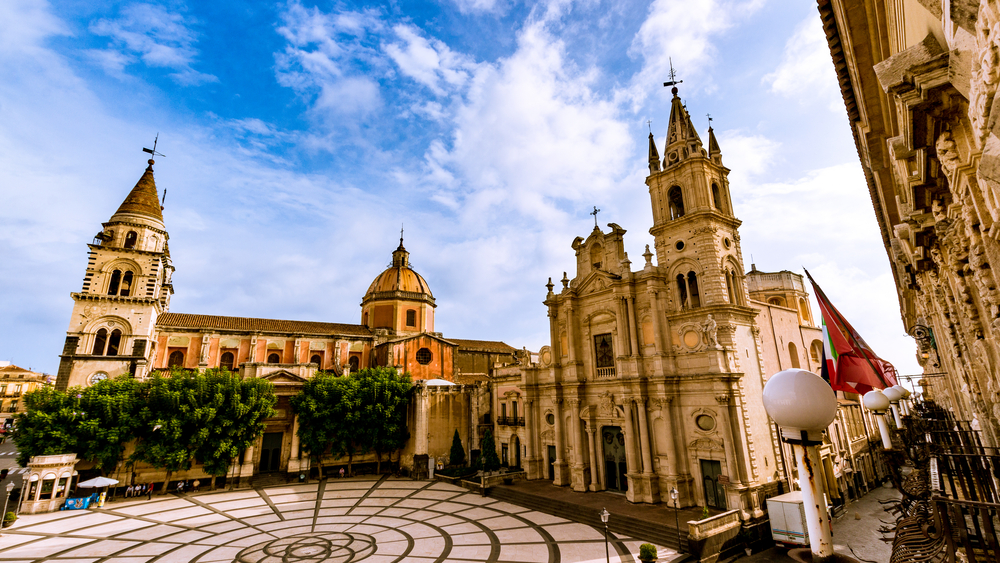
Acireale sits on the Eastern slopes of Mount Etna. Its location has meant that, over the years, it has been destroyed by eruptions but the town that you see today was rebuilt after the 1693 earthquake and its centre boasts some impressive Baroque architecture. Head to the Piazza Duomo to start your tour of the town where you’ll find the Palazzo Comunale, the church of San Pietro e Paolo as well as the impressive cathedral built in the late 1500s, topped with two bell towers covered in colourful majolica tiles. Also nearby is the Teatro dei Pupi, well worth a visit to witness one of their famed puppet shows. Historically visitors flocked to the spa town to visit their sulphur baths but these days the town is probably more famous for its annual carnival celebrations in February.
Aci Trezza
A picturesque fishing village, Aci Trezza is home to the Isole dei Cicolpi, rocks that rise out of the sea and which are now a nature reserve. So the story goes (according to Homer anyway), the rocks were thrown by the blinded Polyphemus (Cyclops) as he tried to hit the fleeing Ulysses who had caused his blindness. Enjoy some time relaxing on the rocks by the sea or in the Ghenea beach club where you’ll find loungers arranged on decking with steps leading into the sea.
Agrigento
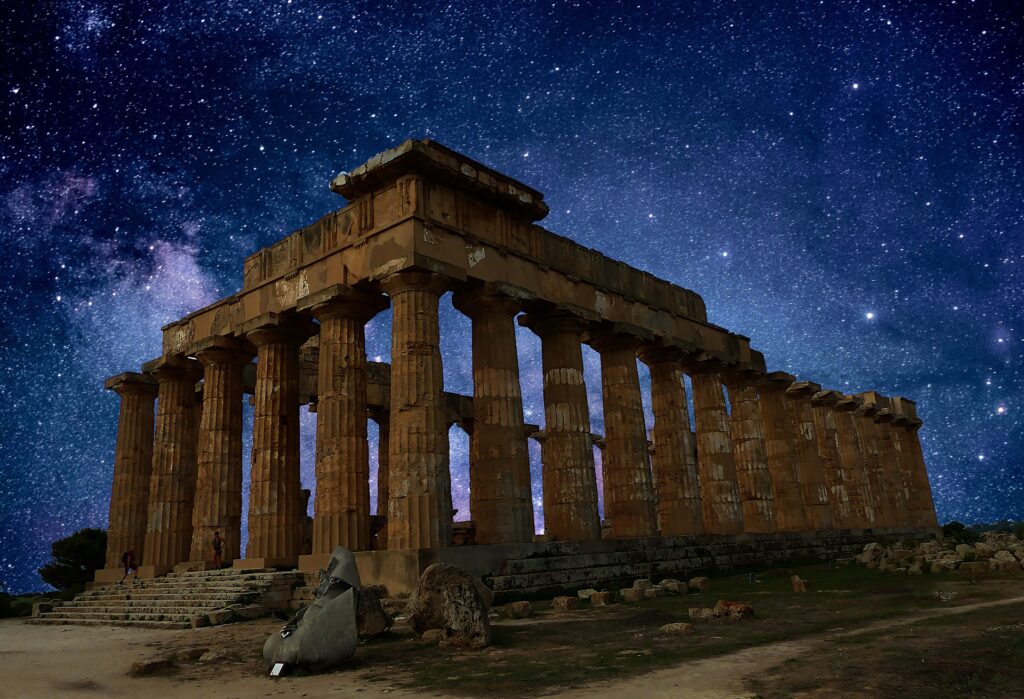
Agrigento is one of Sicily’s most ancient towns, founded in 581 BC. The old Medieval town is well worth a visit. Visit the Cathedral founded in the 12th century and enlarged in the subsequent centuries and meander along the Via Atanea, the town’s main street. However, most visitors head to Agrigento today to marvel at the Valle dei Templi, which has been one of Italy’s UNESCO World Heritage sites since 1997. Nowadays, this vast archaeological site covers an area of over 3200 acres and includes an array of Doric temples and buildings including the Temple of the Dioscuri and the Temple of Olympian Zeus. The latter is certainly the greatest Doric temple in the Western world, measuring over 30 metres tall and with enormous statues over 8 metres tall positioned between the temple’s columns. Unfortunately not all of these have survived but visitors can see a copy of one lying next to the ruins allowing you to appreciate the sheer scale of the building. The Valley of the Temples is also home to the Temple of Heracles (probably the oldest of the buildings), the Temple of Hera Lacinia and the Temple of Concordia. The latter is the best preserved building on the site since it was converted into a Christian Church in the sixth century AD. Visitors can also view ingenious aqueducts, mosaics from ancient houses and other Greek and Roman public buildings within the site.
Avola
A Sicilian village whose origins go back as far as the ancient Greeks and Romans, Avola has historically been an important fishing port whose main catch was tuna. Visitors today can see the remains of the Vecchia Tonnara where the tuna would have been killed and the meat extracted. Like Acireale, Avola was destroyed by Etna’s eruptions and earthquake in 1693 so what you see today was built in the 18th century. Explore the charming streets where you will find the Teatro Comunale, the Vecchio Mercato and remains of a Benedictine monastery. These days, the town is more famous for its almond production and its wine – Nero d’Avola – a full bodied red. It’s a good place to visit if you’d like to enjoy an authentic slice of Italy, particularly if you are there during one of their many festivals. The town has a sagra to celebrate everything from almonds to wild boar and swordfish!
Caltagirone
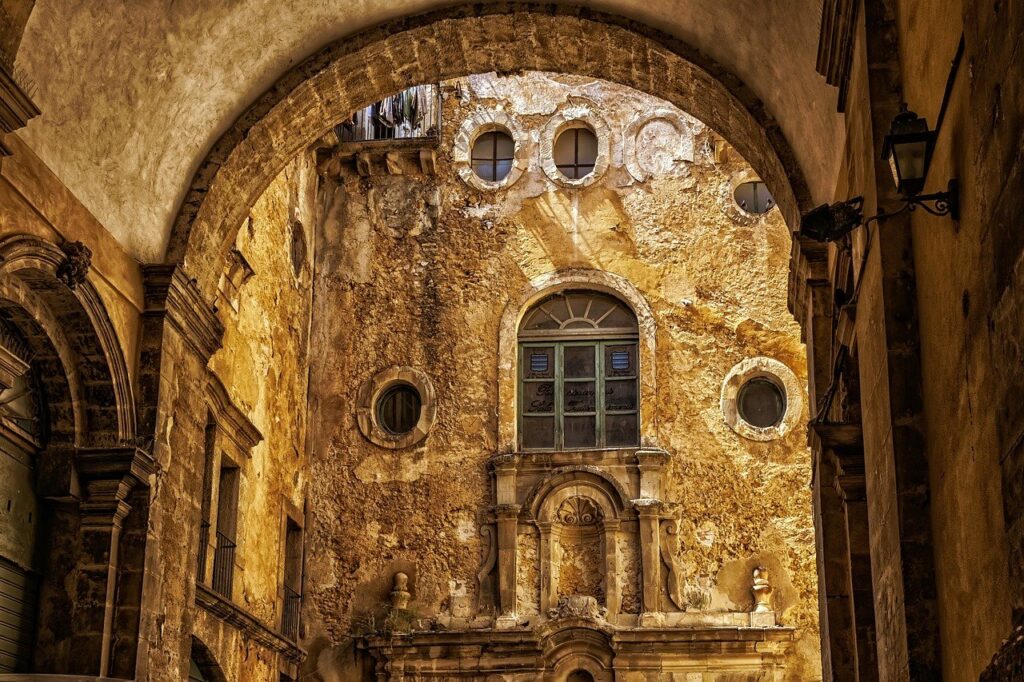
Another of Sicily’s UNESCO World Heritage sites, Caltagirone is most famous for its production of ceramics. Wherever you wander in Caltagirone, you’ll be surrounded by these bright colourful tiles and nowhere are these more spectacular than in the 142 majolica covered steps of the Santa Maria del Monte staircase. Built in 1606, the staircase connects the upper and lower parts of the town. Visit if you can in the last two weeks of May when the annual Infiorita takes place and when the steps will be even more colourful, covered with flowers. Or go instead in the middle of August during the Illuminata, when thousands of candles light up the steps. You can find out more about the ceramics production by visiting one of the many artisan workshops or by visiting the Museo Regionale della Ceramica. Start your visit in the heart of the town – the Piazza Municipio – before exploring the town’s other main sites such as the Duomo di san Giuliano, Santa Maria del Monte and the public gardens.
Castellammare del Golfo
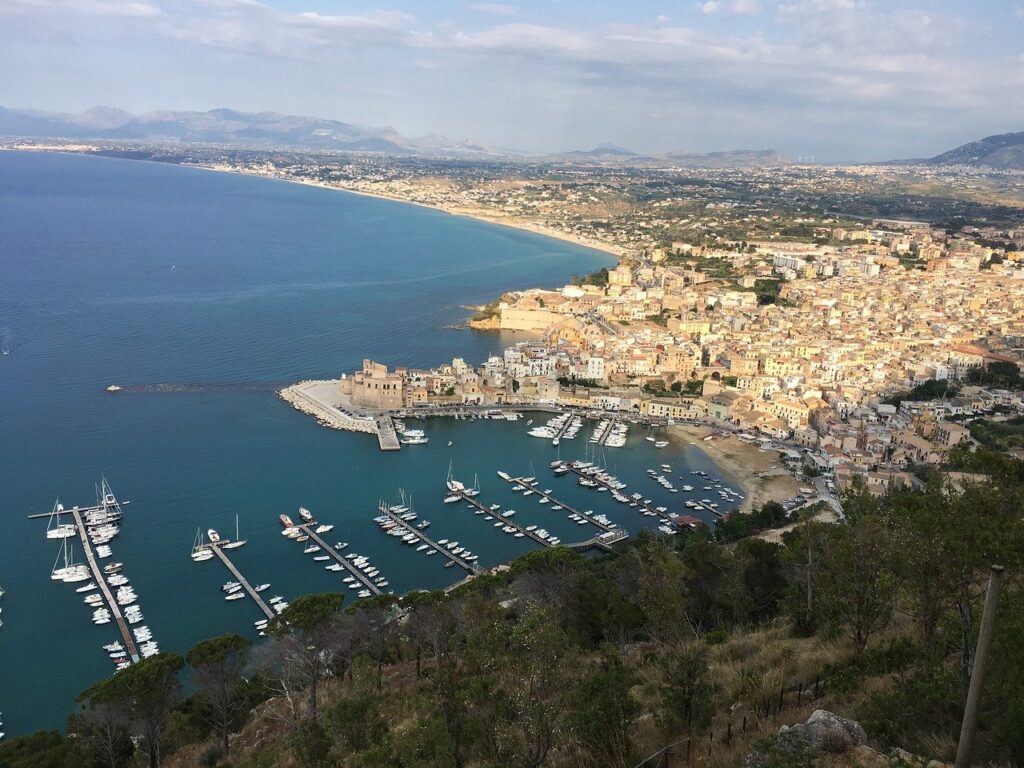
Castellammare del Golfo is an attractive seaside town, set around its fishing port – Cala Marina – where it is still possible to witness fisherman bringing in their daily catch. Holidaymakers can take a boat trip from here to San Vito Lo Capo, or can opt for a trip to explore some of the smaller coves on this stretch of the Sicilian coastline only accessible from the sea. Or, if you prefer, you can even head out from here to try a spot of fishing for yourself.
Arguably the most important site to see here though is the castle. Nestled at the end of the promontory, almost jutting into the sea is the castle which dates back to Arab times but underwent modifications under the Normans. These days, it’s open to the public and is home to a museum, part of which covers the history of the tuna fishing industry whilst another section explains more about the town’s most important festival – the re-enactment of the Madonna del Soccorso – which takes place on 13 July each year. Head to the town on that day and you will see local residents dressed both as angels and English invaders! Below the castle is a small beach and marina, where you will find a good selection of restaurants serving up delicious, freshly caught seafood. The town’s larger beaches are Cala Petrolo and La Plaja.
Castelmola
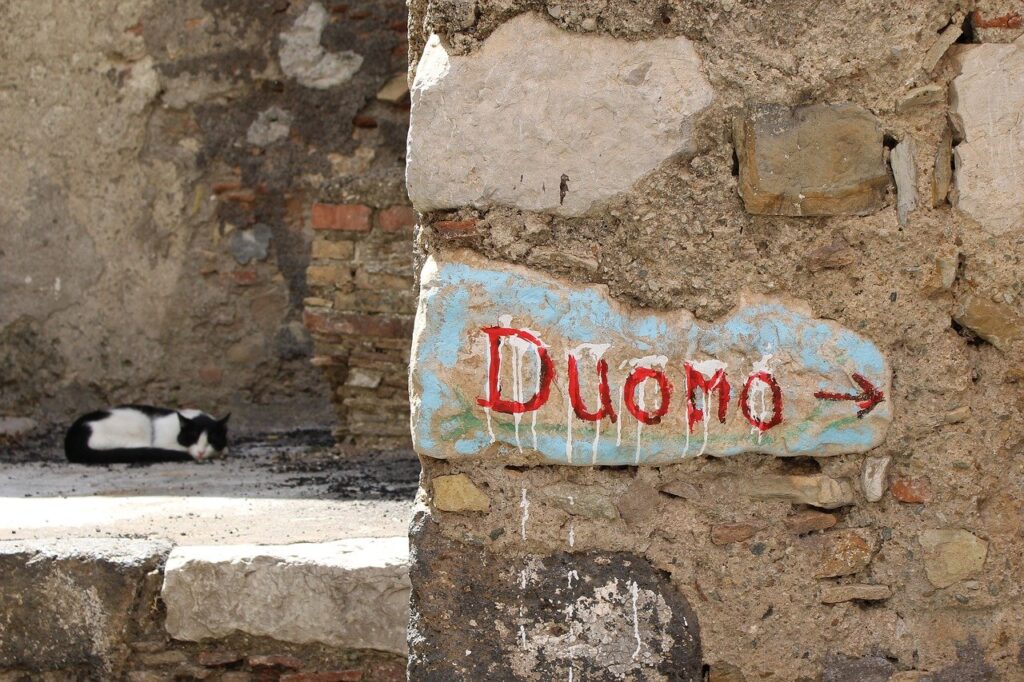
Castelmola is a tiny village that sits high above Taormina. It’s worth a visit for the views alone. Its size means it won’t take long to explore but you may be surprised by what you find here! It is home to the Bar Turrisi, a café that has become famous for its displays of penis-shaped memorabilia that the owners have been collecting for years and which has given the village a claim to fame, something that many of the souvenir shops have latched on to by selling various ‘penis’ souvenirs! Whether you decide that café is your cup of tea or not, I can recommend that you sample the almond wine before leaving the village. The wine is a speciality of the village. Enjoy it with cantucci dipped in to absorb the liquid!
Castiglione di Sicilia
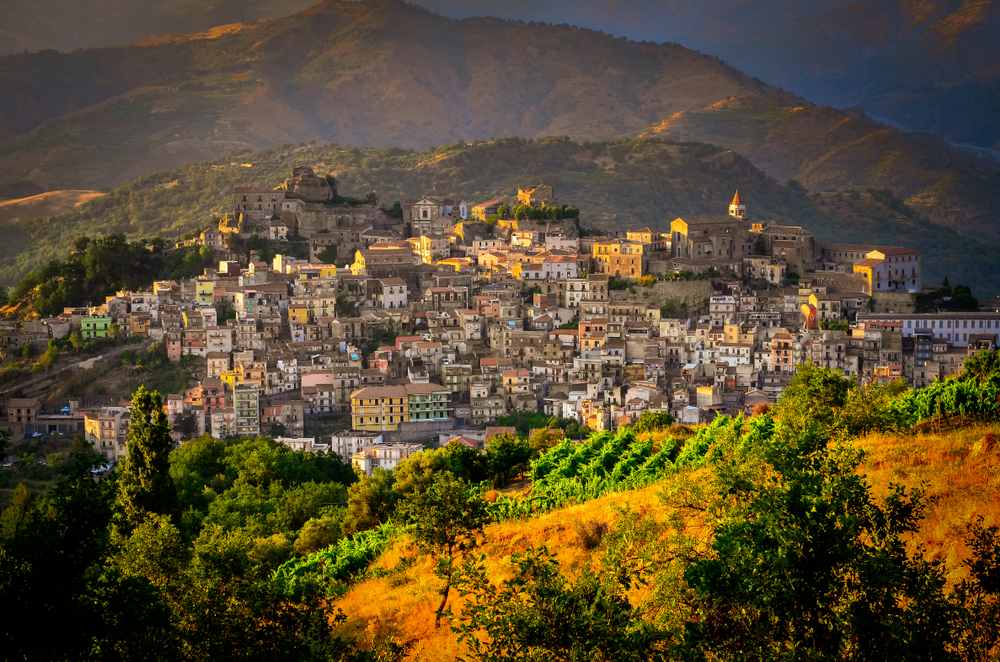
Voted one of the ‘borghi piu belli d’Italia,’ Castiglione di Sicilia is a delightful village situated on top of a hill between the Alcantara Valley and the Etna Park. The town is dominated by the Norman Castle of Lauria but it is also home to a number of interesting churches including the Chiesa Madre, Chiesa delle Benedettine and Chiesa della Catena. Start your tour in the heart of the town in the Piazza Lauria.
Castroreale
Castoreale is a small Medieval village in Sicily, characterised by narrow streets and home to a huge number of churches given the number of residents it is home to. Some of the most important of these include the 16th century Church of Santissimo Salvatore and Torre Campanaria, the Church of Candelora, the 13th century Church of Santa Marina, the Church of Sant’Agata and the Cathedral of Santa Maria Assunta. The latter is home to an important sundial built in the 19th century.
If you do visit Castoreale, make sure you try the village speciality – delicious biscuits called u biscottu castricianu, made from aniseed, cinnamon, lard, sugar, cloves, vanilla, yeast, flour, water and salt. So delicious are they that there is even an annual festival every August devoted to this sweet treat.
Catania
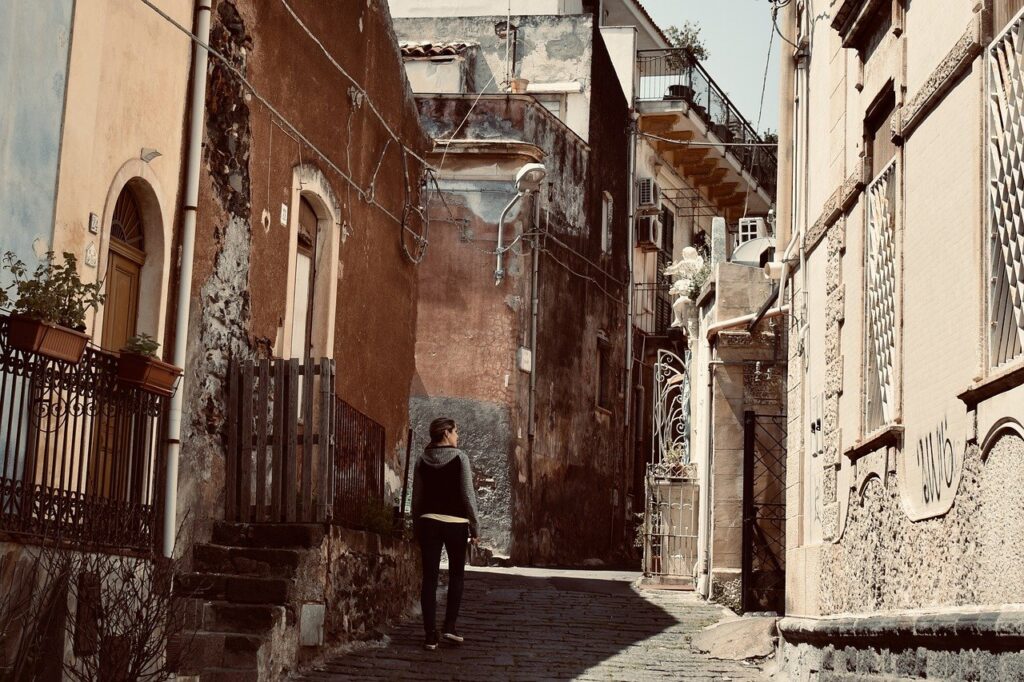
Catania is Sicily’s second biggest city behind Palermo and is another of Sicily’s UNESCO World heritage sites along with the other seven towns that make up the late Baroque Towns of the Val di Noto. Its origins date back to the ancient Greeks and Romans and evidence of these early settlers can still be seen today. Remains still exist of the Teatro Romano in Via Vittorio Emanuele, which was built using lava stone. Also still to be seen is the smaller Odeon next door, both open to the public. Finally there is the amphitheatre, once able to seat 15,000 spectators making it the largest in Sicily. Whilst this isn’t usually open to the public, it can still be viewed from outside.
But, like so many of Sicily’s towns, Catania’s history has been impacted hugely by its position in Etna’s shadow, destroyed twice in the 17th century first by an eruption in 1669 and then by an earthquake less than a quarter of a century later. This led to the rebuilding of the entire old part of the town in the Baroque style of the time. What makes it truly original though is the fact that the building material used was lava.
We recommend you start your visit of Catania in the main square – the Piazza Duomo – where you will find the Cathedral of Saint Agata, built on top of Roman baths as well as the 18th century Town Hall and Diocesan Museum. Saint Agata is the patron saint of the city and there are two other churches in the city named after her. Catania also celebrates the saint for 3 days from the 3rd to the 5th of February.
In the very centre of the Piazza Duomo is an impressive 18th century fountain whose base represents the two main rivers of Catania whilst on top sits an elephant made from black lava and with an Egyptian obelisk on its back. Also worth a visit in Catania is the Museo Belliniano, where you can learn more about the composer Vincenzo Bellini, Catania’s most famous son. If you visit Catania during the opera season that runs from October to June, try and visit the Teatro Massimo Bellini. Incidentally, Bellini is buried in the cathedral in the city.
The city really is full of beautiful buildings but before you leave Catania, don’t miss out on seeing the Palazzo Biscari as well as the Monastery of San Benedetto. Enjoy a guided tour of the latter to discover everything from the archaeological remains of a Roman house to a contemporary art museum. The other monastery not to be missed is the Baroque monastery of San Nicolò l’Arena, one of the largest Benedictine buildings in Europe.
If you’re a keen foodie, then make a point of heading to the fish market in Catania one morning. It’s quite an experience with fish, fruit, vegetables and meat sold on marble counters under large red and white awnings. And make sure you try the local speciality – Pasta alla Norma – a delicious dish of pasta and aubergine covered in a tomato sauce and topped with grated ricotta cheese.
Cefalu
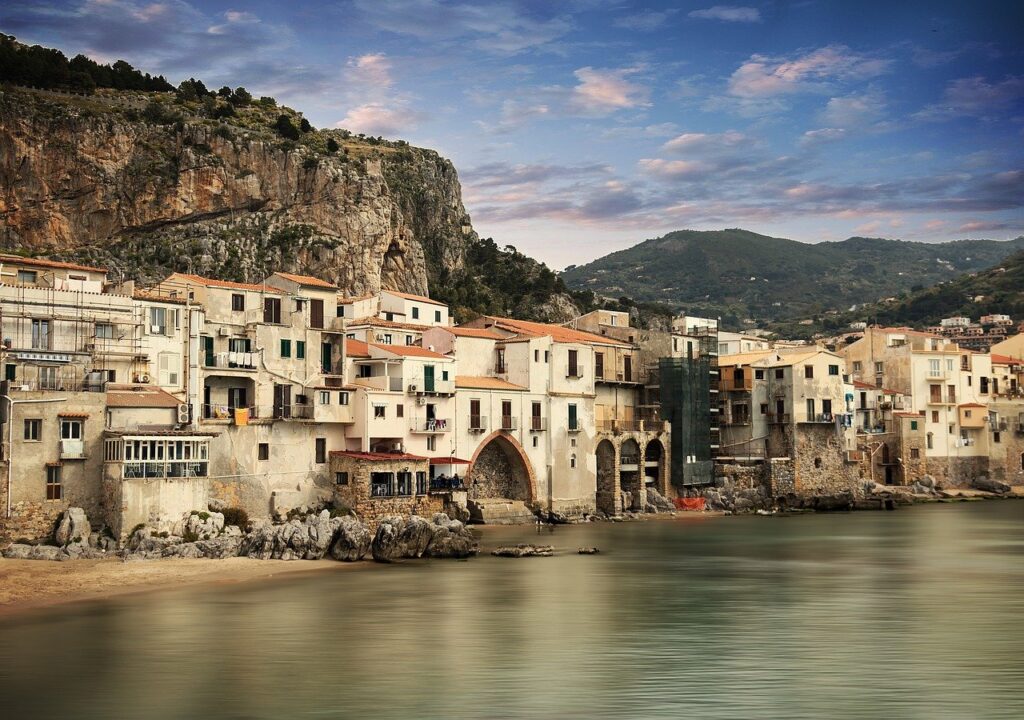
Cefalu is a charming, picture-postcard seaside town on the North coast of Sicily. We’re not surprised that Giuseppe Tornatore decided to film parts of Cinema Paradiso here. Take time to admire the spectacular Duomo. The exterior with its two towers are striking, but the real gem of this building are to be found inside. Here you’ll discover Byzantine beautiful mosaics.
One of the things we definitely you do when in Cefalu is actually to climb above the town to enjoy the views over it. Take a walk up to the 4th century Roman Temple of Diana to escape the crowds and enjoy the views over the dazzling sea below or head even further up the mountainside to La Rocca. The latter is home to the remains of an 11th century Norman castle and those who brave the climb will be rewarded with tremendous views over Cefalu and even of the Tempio di Diana below. You’ll be able to see Cefalu’s beautiful beach below, popular with both locals and tourists alike.
And if you head down to the water, make sure you head to the old harbour too. You’ll find children jumping into the water below and fishermen catching fish.
Finally, before you leave, check out the Museo Mandralisca, home to the famous ‘Portrait of an Unknown Man’ by Antonello da Messina, a work of art that has been compared to the Mona Lisa when it comes to his intriguing smile.
Want to discover Cefalu for yourself? Then, stay at this eco-friendly villa near Cefalu.
Enna
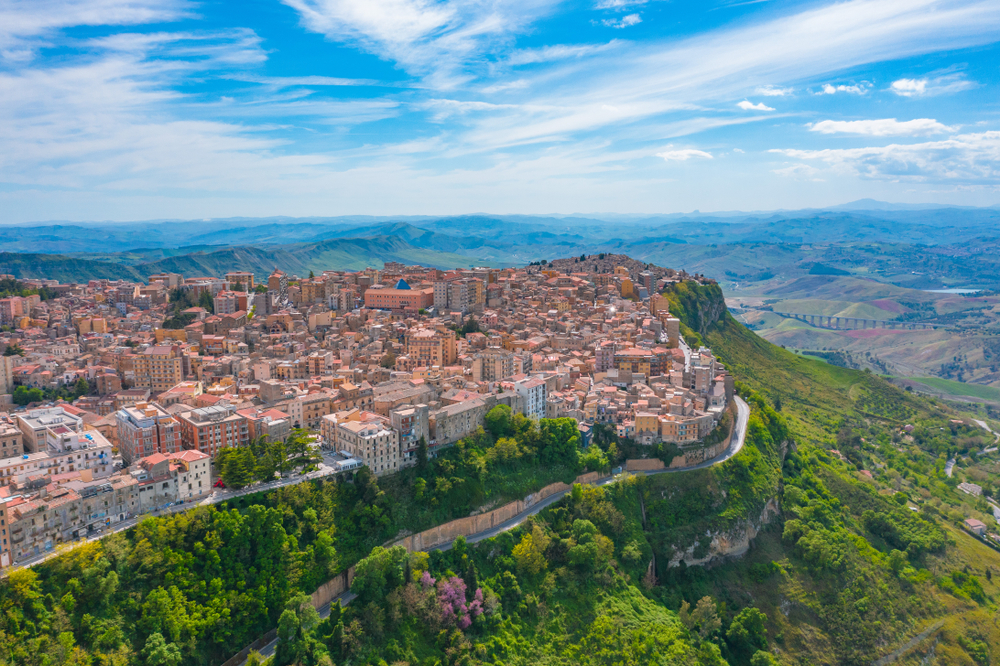
Perched 931 metres above sea level, Enna dates back to ancient Greek and Roman times. There is plenty to admire here, not least the incredible views that its elevated position delivers. For the most impressive views of all, head to the Rocca di Cerere, site of the ruins of the Temple of Demeter
Enna itself is split into two parts – the sleepy, hilltop historic centre, Enna Alta (which is where you will find all the main sights), and the modern town below, Enna Bassa. In the Enna Alta is the Castello di Lombardia which dominates the town. Only six of the original twenty towers remain but it’s still impressive. Visit in the Summer months and you may be lucky enough to be able to watch a play in its inner courtyard. Also in the historic centre is the Torre di Federico, an octagonal shaped tower in the towns public gardens, and the Cathedral with its beautiful interior, three naves and wooden roof. The Duomo was actually destroyed by fire in the mid 15th century but was rebuilt over the next 200 years. And opposite this is the Varisano Archaeological Museum, home to numerous artefacts along with the Alessi Museum, home to important religious artefacts. And of course, make the most of .
If you are in Enna on 2 July, you’ll be able to take part in the procession of the Madonna della Visitazione, the patron saint of the city when the statue of the Madonna is carried through the town. Just to warn you though, you may be woken at 7 in the morning by the sound of gunfire!
Erice
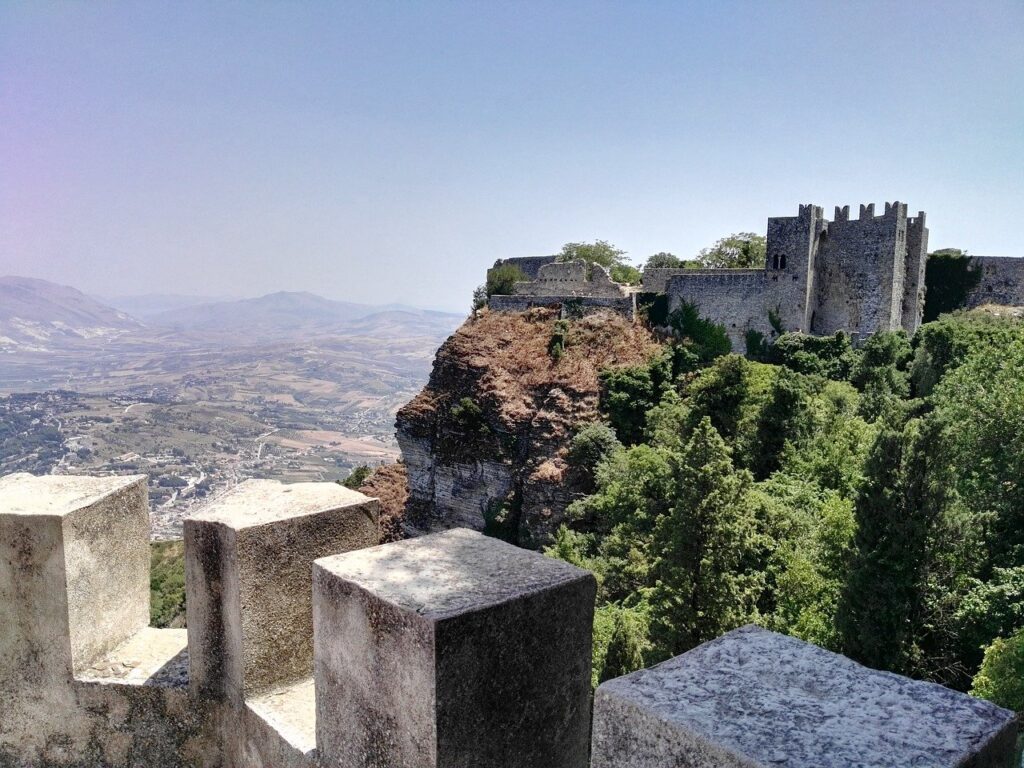
The pretty, triangular shaped Medieval town of Erice sits 800 metres above sea level, atop Monte San Giuliano, in the province of Trapani. Surrounded by thick defensive walls and dominated by its castle, the town is well preserved and characterised by narrow streets, charming piazzas and beautiful streets paved with different sized shiny stones and filled with a plethora of churches. We think that the best way to reach it is via a 10 minute cable car (funivia) ride. Jump on at the bottom in the outskirts of Trapani and enjoy the wonderfully panoramic views over Trapani, the coast, the sea and the Egadi islands as you ascend.
The cable car will drop you off at the Porta Trapani gateway. From here, walk along the main street – Vittorio Emanuele – to the main square, the Piazza Umberto I where you will find the 14th century Chiesa Madre. Climb up the steps of adjacent bell tower (Torre di Federico II) to enjoy the views. You’ll also find the Palazzo del Municipio in the square, home to a museum where you can learn more about the history of the town.
Or instead, start your visit by following the line of the walls to the 12th century Castle of Venus (Castello di Venere) and the Giardino del Balio where you can enjoy views over the countryside below. However, the best views which stretch all the way to the sea are certainly to be found in the castle itself. In fact, it is even possible to see all the way across the sea to Tunisia on a clear day (number 26 on our list of 60 things to do in Sicily). Although, that said, due to the height of the town, you’re not guaranteed a view unless it’s a clear day… the town can often get lost amid the clouds and mist!
Other churches worth a visit include the Chiesa di San Giuliano, the Chiesa di San Martino and the Chiesa di San Pietro.
Ferla
Ferla is a small village in the UNESCO World Heritage area of the Val di Noto. Like so many towns and villages in this area, it was completely destroyed in the earthquake of 1693 but the subsequent rebuilding has been impressive! The most famous street in the village is the Via Sacra, home to five key religious buildings, namely the Church of Carmine, the Chiesa Madre, the church of Sant’Antonio, the Church of Santa Maria and the Church of San Sebastiano. The latter is the largest of the churches and contains the relics of San Giovanni Battista, San Sebastiano, Santa Lucia and Santo Stefano.
Fontane Bianche
Fontane Bianche is not really a town or a village, but instead it emerged when Sicilians built their holiday villas there in the 1960s. Now, it’s a 4 km stretch of coastline that sits to the south of Siracuse, 1.2 km of which can boast the most glorious white sandy beach (whilst the rest is a rocky beach known by the Sicilians as scogliera) and so we reckoned deserved a mention in our A to Z of Sicily!
Gangi
Another of the ‘borghi piu belli di’Italia’, Gangi is a small but charming village. Its most notable buildings include the 18th century Baroque style Santuario dello Spirito Santo where you will find the miraculous image of the Eternal Father painted on a rock. Originally found by a farmer, today the artwork sits inside the church. Also worthy of note are the two palaces – the Palazzo Bongiorno and the Palazzo Sgadari (now home to a museum) – and the tower of Ventimiglia. And of course, last but not least is the Medieval castle which sits at the top of the town on the Mount Marone.
Geraci Siculo
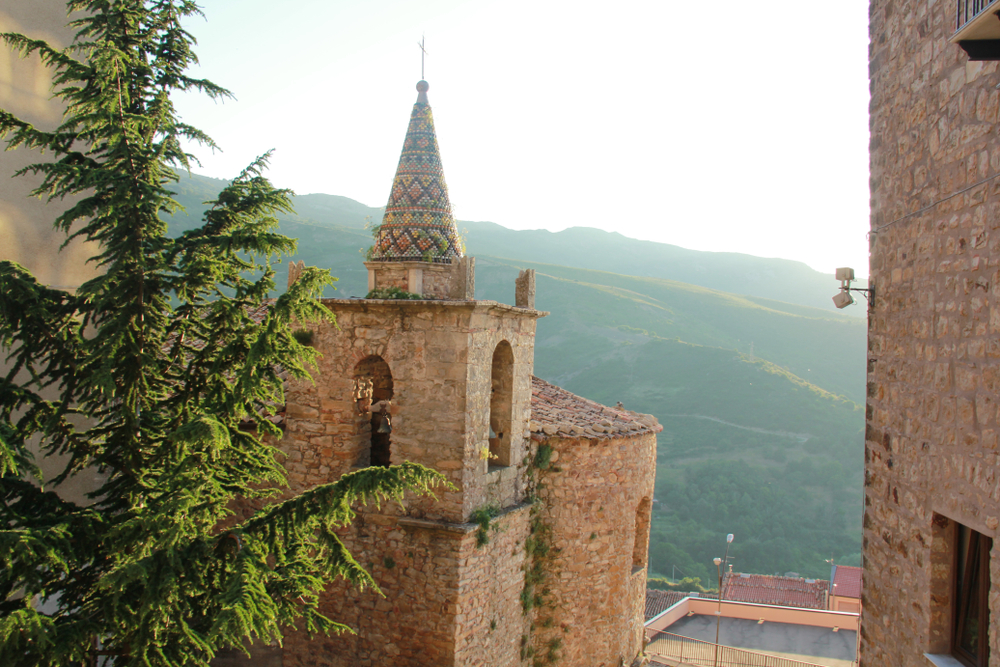
A tiny hilltop village and another of the ‘borghi piu belli di’Italia’, Geraci Siculo is characterised by narrow alleyways, cobbled pathways, small churches and charming courtyards. It offers a chance for visitors to experience a slice of authentic Silician life. It certainly feels like stepping back in time, as it seems that little has changed here since the village was built! There isn’t much here to visit apart from the 11th century, Ventimiglia Castle and 14th century church of Saint Giacomo. But, sitting as it does 1000 metres above sea level in the heart of the Parco delle Madonie regional park, the views from the village of the surrounding countryside below are incredible!
Giardini Naxos
A seaside town not far from the hustle and bustle of nearby Taormina, life here is centred about the line of hotels, bars, restaurants and souvenir shops that face the beach – the Lungomare. In the Summer months, you’ll find it bustling with holidaymakers who enjoy the long stretch of white sandy beaches, swimming and snorkelling that is on offer during the day and the vibrant nightlife it offers each evening. Whilst little evidence remains of the town’s ancient roots, Giardini Naxos actually dates back to the early Greek settlers of the 5th century BC and it is possible to learn more about its fascinating past at the archaeological park and museum situated at the Capo Schiso towards the Southern end of the town where excavations to unearth its past are underway.
You may want to consider visiting Giardini Naxos during the annual Sagra del Pesce (fish festival), or on a Saturday morning when there is the weekly market.
Marina di Ragusa
Marina di Ragusa is a Sicilian village and beach resort, famous for the Gioco del Palo which takes place each year on 15 August. Head to the village on that morning to witness competitors attempting to mount a greasy pole to reach the flag at the top. It’s a hilarious spectacle involving plenty of people falling into the water!
Villa Edith is a contemporary villa near Marina di Ragusa, an ideal base for those looking to explore this part of Sicily.
Marsala
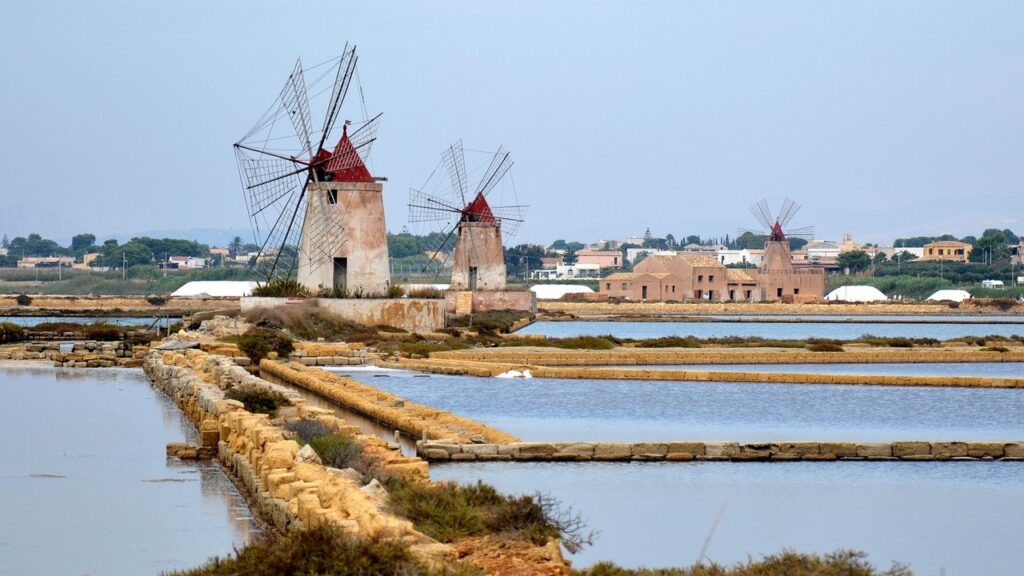
Marsala is probably best known for its wine, whose origins and notoriety owes much to the English. Liverpudlian John Woodhouse stumbled across the local wine in 1773, loved it and thought that his native Englishmen back home would enjoy it too. but to survive the long journey overseas, the wine would need to be fortified, thus marks the origins of Marsala wine. Woodhouse was right and the English did love it… so much so, in fact that he moved to Marsala in 1796 to begin mass production of the stuff!
The town’s other claim to fame is that it was where Garibaldi and his thousand men (the Mille) landed on May 11th 1860, an event that started the chain of events that preceded Italy’s unification. Walk through the streets of Marsala and you’ll come across numerous commemorative plaques along with a number of businesses that use Garibaldi’s name.
Many holidaymakers will visit the town to enjoy a tour of the wineries and sample the famous drink. But there is plenty else to be seen here. Marsala itself is a pleasant place to visit with a lovely pedestrianised Baroque town centre, a beautiful cathedral dedicated to the English Saint, Thomas Becket and an interesting archaeological museum. Don’t miss the nearby salt pans and nature reserve of Il Stagnone either.
Villa Lily is a stunning 4 bedroom villa near Marsala, the perfect base to explore this fascinating town.
Marzamemi
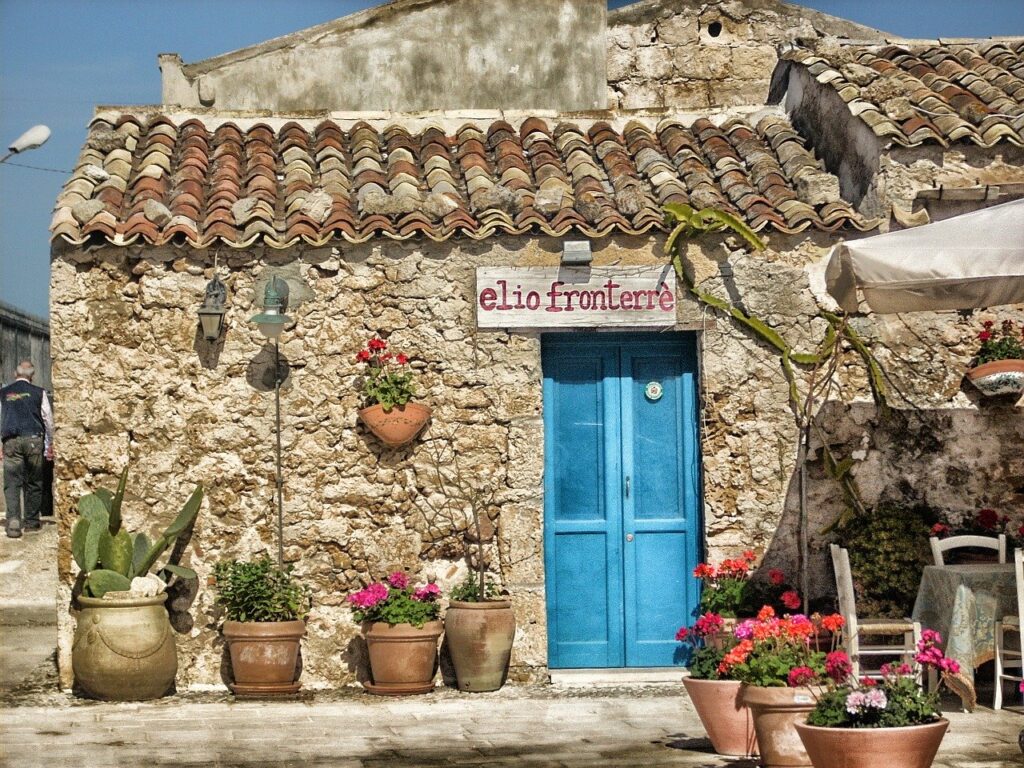
Sitting at the Southern tip of Sicily, Marzamemi has become a popular Summer destination for tourists. The village was founded by the Arabs and certainly Marzamemi would arguably look more at home in a Moroccan or Arabian setting than an Italian one. We think it’s one of the island’s prettiest seaside villages. Once an important centre for tuna fishing, these days the tonnara here is no longer functioning but there is still a thriving artisanal fishing and processing industry producing everything from tinned tuna to smoked swordfish. Its main piazza – Piazza Regina Margherita – is absolutely charming, home to the cathedral, the old tonnara, the town’s main palazzo along with several cafes. Leading off the main square, there are charming streets lined with old fisherman’s houses with sky blue painted doors and contrasting red geraniums spilling out of their pots. Off of it, what served as fishermen’s houses line up with charming effect. Just as charming is Marzamemi’s fishing harbour filled with the reds, blues and yellows of the fishermen’s brightly coloured wooden boats bobbing on the water.
Mazara del Vallo
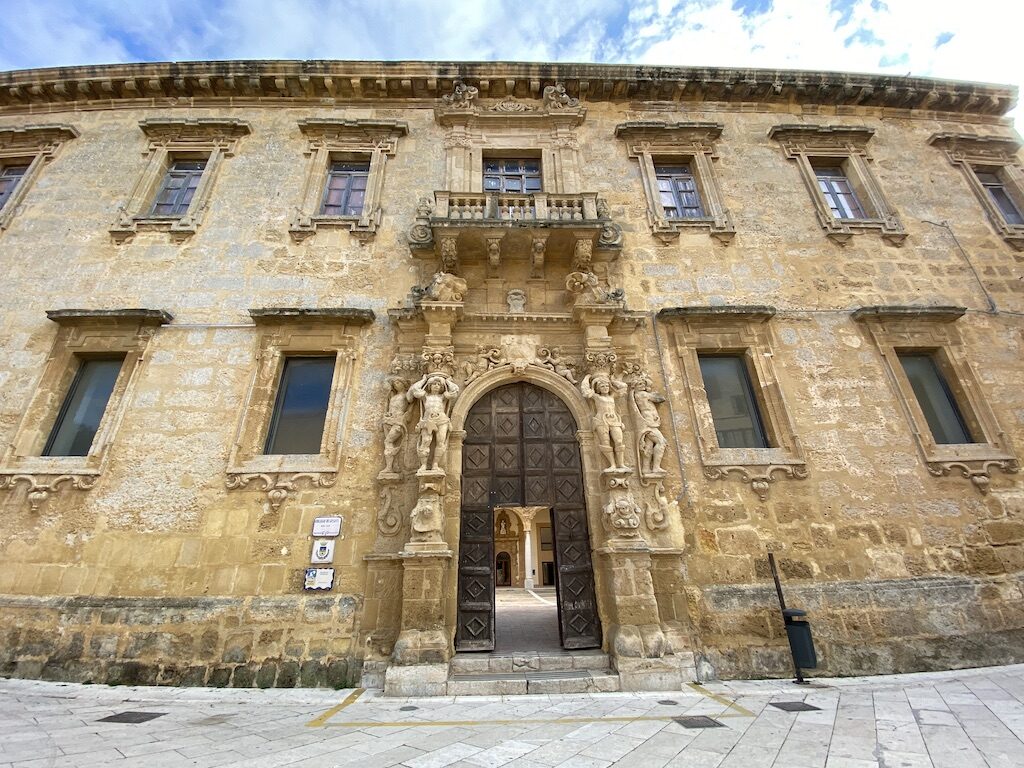
Over the years, Mazara del Vallo has enjoyed a rich and varied history, under the rule of the Phoenicians, Greeks, Romans, Arabs, Normans, Aragonese, Bourbons and Habsburgs until it was ‘liberated’ by Garibaldi in 1860 when it became part of the new united Italy. Much of this chequered history is still evident as you explore the town today. For example, head to the Kasbah quarter to really see the Arab influence where around 3000 Tunisians still live today. Here you’ll find many houses built in a typical Arab style many with decorative tiles on their facades. Or wander the streets to discover the Norman churches that still exist including the 12th century Chiesa di San Nicol o Regale and the Chiesa della Madonna delle Giummare. Also of note is the beautiful Piazza delle Repubblica where you will find the beautiful cathedral, the Palazzo del Seminario, the town hall and the Bishop’s Palace.
Today, Mazara del Vallo is still home to the largest fishing fleet in Italy but probably it’s more famous for a discovery made back in 1998 by Captain Francesco Adragna. On the evening of 4 March that year, whilst out fishing, caught in his nets was an incredible 7 foot bronze statue of a dancing satyr. It turned out that the statue in fact dated back to some time between the 4th and 1st centuries BC and visitors can now view it in the Museo della Satira Danzante in the heart of the town.
Milazzo
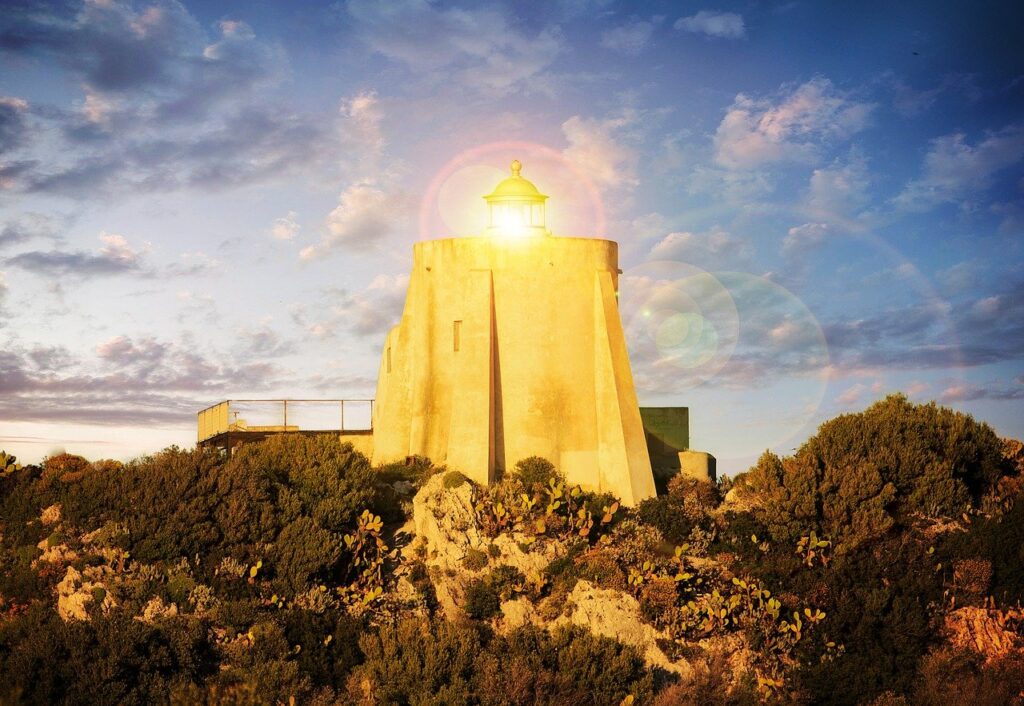
Whilst many are put off by the industrial part of Milazzo, choosing instead only to head there in order to get to the Aeolian islands, the town is definitely worthy of a visit in its own right. It is divided into two parts – the old walled town (borgo antico) and the newer more industrialised lower town – and its the former which is where you’ll find its charm. Here, there are some beautiful old pastel coloured buildings and churches to be admired.
However, if heading here, one thing you shouldn’t miss is just outside town at the Capo Milazzo.
The old town centre itself is charming and retains some fine buildings and churches, while the cape is also well worth exploring, particularly the splendid Norman castle, the cavernous rock church of Sant’Antonio di Padua and the beaches of the Riviera di Ponente. Great views and sunsets are guaranteed and there are several good walking tracks.
The seafront palm-lined promenade offers a lovely place to walk and enjoy views of the water and the scent of the sea. Take the panoramic road outside town to Cape Milazzo, and the rock-hewn shrine of Sant’Antonio, with its multi-colored marble and bas relief sculptures. It is reached by a trail, and is built on the site that the saint was shipwrecked in 1221. The cape is famous for the Piscina di Venere (also called laghetti di Venere), or the Pools of Venus, pretty paradise of natural rock pools filled with crystalline water that are well worth the hike. The drive is gorgeous along the rugged coast to the lighthouse on the cape.
Walk around the historic center and soak in the atmosphere of the adorned palaces and churches, and pastel-painted buildings decked with decorative wrought iron balconies. It’s a pretty, sunny place. There is a nice Antiquarium museum containing a plethora of artifacts.
Militello in Val di Catania
Included in the list of eight towns that make up the Val di Noto site that was declared a UNESCO World heritage site, Militello in Val di Catania is a beautiful town. Like so many towns in Sicily, it has a rich and diverse past but its heyday was certainly between the 15th and 18th centuries, when it was under the control of the Princes of Branciforte. Across this period, numerous spectacular buildings were erected, among them dozens of palaces and a plethora of churches. It’s still possible to see where the family would have lived. Head to the end of the Via Porta della Terra to see the two remaining towers of the Barresi-Branciforte Castle along with the rooms of the oil mills and the south ramparts.
The religious buildings of note include (but are by no means limited to) the Church of San Benedetto, the Chiesa Madre San Nicolò e del SS. Salvatore, the Madonna della Catena Oratory, the Church of Santa Maria la Vetere and Sanctuary of the Madonna della Stella.
Modica
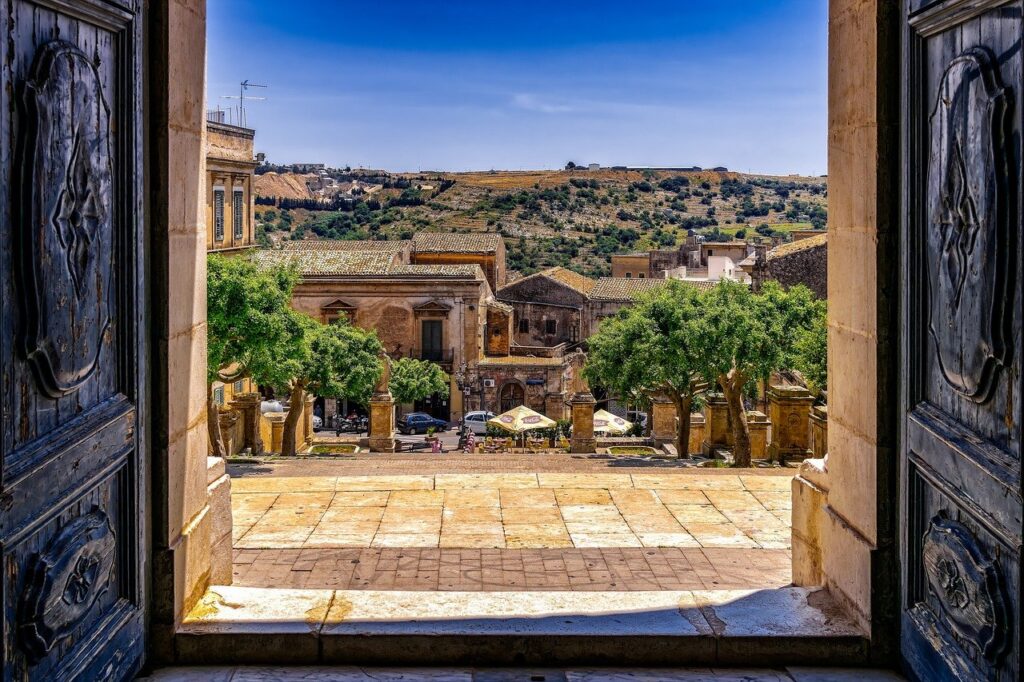
Another of the eight UNESCO World Heritage towns that make up the Val di Noto, Modica is one of Sicily’s most distinctive towns with buildings appearing to be almost stacked on top of each other. Baroque styled Modica is divided into two parts: Modica Alta (the higher part) and Modica Bassa (the lower part), connected by numerous narrow streets, steps and staircases.
The town is absolutely full of incredible Baroque masterpieces, arguably the most notable of which are the facade of the Palazzo Polara, the 13th century Castello dei Conti and the Church of San Giorgio, famous for its 250 steps which connect the upper and lower parts of the town and where you can enjoy incredible views over the city from the outside and enjoy the incredible works of art inside.
In fact, Modica is affectionately known as the ‘city of a hundred bells and a hundred churches’, so this church is just one of a number of religious buildings. You’ll be doing well to visit even half of them but others you may want to add to your list include Modica’s oldest – the 12th century San Nicolo Inferiore carved into the rock – as well as the Duomo di San Pietro in the lower part of town (decorated with statues of the 12 apostles) and the Chiesa di San Giovanni Evangelista, sat on top of an impressive tree-lined staircase. The latter can be found at the very top of Modica Alta and is the highest point in the town so it’s worth heading here just to stand on the viewing platform and take in the breathtaking views. Also worthy of a visit is the Chiesa del Carmine, one of the few examples of the Sicilian Gothic style architecture that remains on the island today.
The town’s main street is the Corso Umberto which makes its way though the Modica Alta and this is as good a starting place as any for your visit. This is where you will find the Palazzo De Leva, the 19th century Teatro Garibaldi and the Museo Civico where you can learn more about the history of Modica.
Modica is also home to Sicily’s famous chocolate production. This is chocolate possibly unlike any you have tasted before, since it is made using the ancient Aztec methods of chocolate making, something that Modica owes to the Spanish Conquistadors when Sicily was under Spanish rule. This crumbly chocolate is often flavoured with chilli, cinnamon, raspberry and vanilla. Make a beeline for Sicily’s oldest chocolate shop – Antica Dolceria Bonajuto – to witness the chocolatiers at work (number 37 in our guide to 60 things to do in Sicily)
If you want to discover it for yourself, then why not stay at this luxury villa in Sicily near Modica.
Monreale
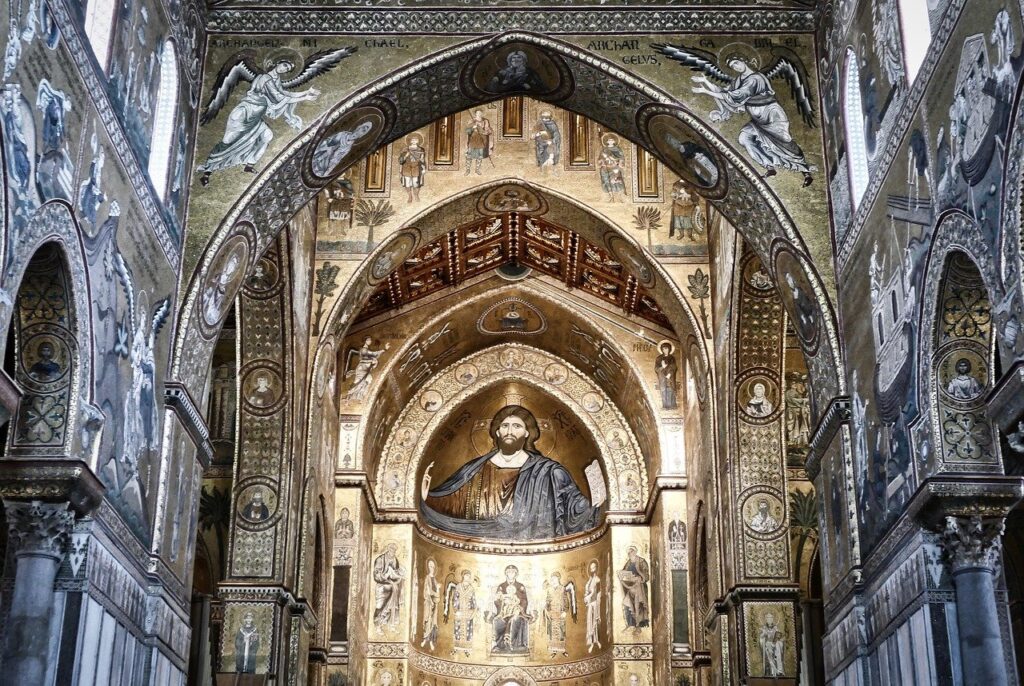
There is absolutely no doubt that Monreale is most famous for its absolutely stunning cathedral (Duomo) and the incredible mosaics that it is home to. The greatest example of a Norman cathedral to be found on Sicily, the upper part of the interior is covered in gold mosaics covering an area of over 6000 square metres and depicting biblical scenes as well as saints, kings and angels. These would have been the creation of Byzantine craftsmen and the whole building clearly shows the different influences in play – the Norman, Byzantine and Islamic. It’s worth the extra ticket cost to view the cathedral treasury (tesoro) where you can get even closer to these mosaics as well as to visit the panoramic terrace. Along with the cathedral in Cefalu, the cathedral was granted UNESCO World Heritage status in 2015.
Adjacent to the cathedral are the cloisters (chiostro) of the 12th century Benedictine monastery. We can highly recommend a visit to explore the large courtyard lined with than 216 twin columns, all decorated with unique mosaics and sculptures.
Montalbano Elicona
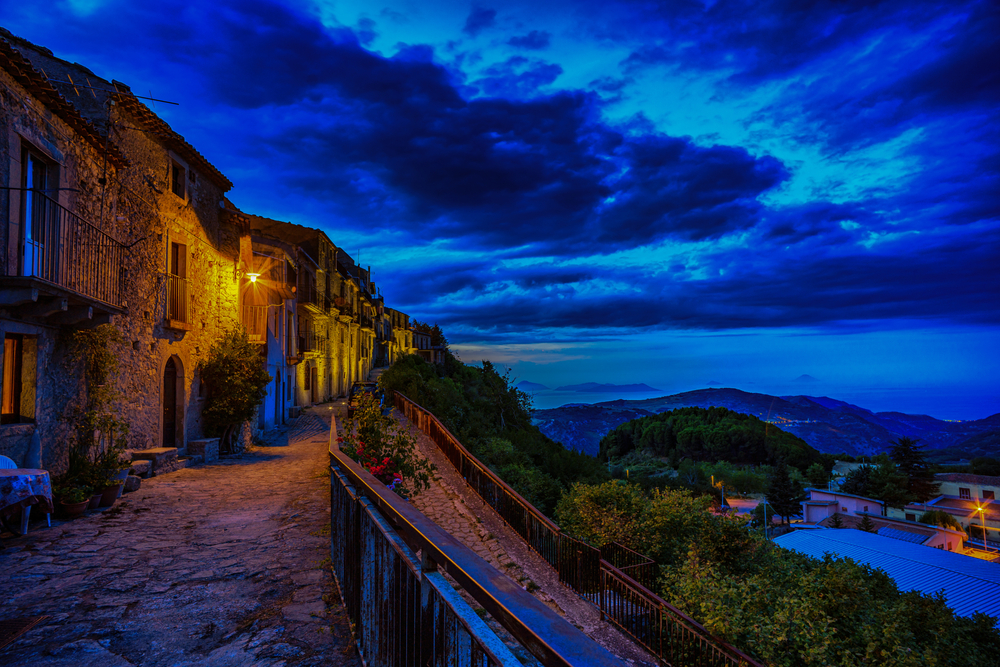
Yet again, one of the ‘borghi piu belli d’Italia‘, Montalbano Elicona is dominated by its Swabian-Aragonese Castle which was once the residence of Frederick II of Aragon. This is certainly a good starting point for any visit to the village. Take time to admire the beautiful Royal Chapel and museum here.
From here, explore the maze of pathways that take you around the village. As you walk, look out for the Basilica of Maria Assunta (home to a 15th century wooden crucifix along with a painting of the Last Supper by Guido Reni) as well as the Romanesque facade of the Church of St Catherine.
Monterosso Almo
Monterosso Almo is a charming little village that sits that clings onto the mountainside, 700 metres above sea level. Visit in the last Sunday in August to take part in the Sagra del Pane (bread festival). Enjoy it warm drizzled with olive oil, oregano and cappuliatu (sun dried tomatoes).
Noto
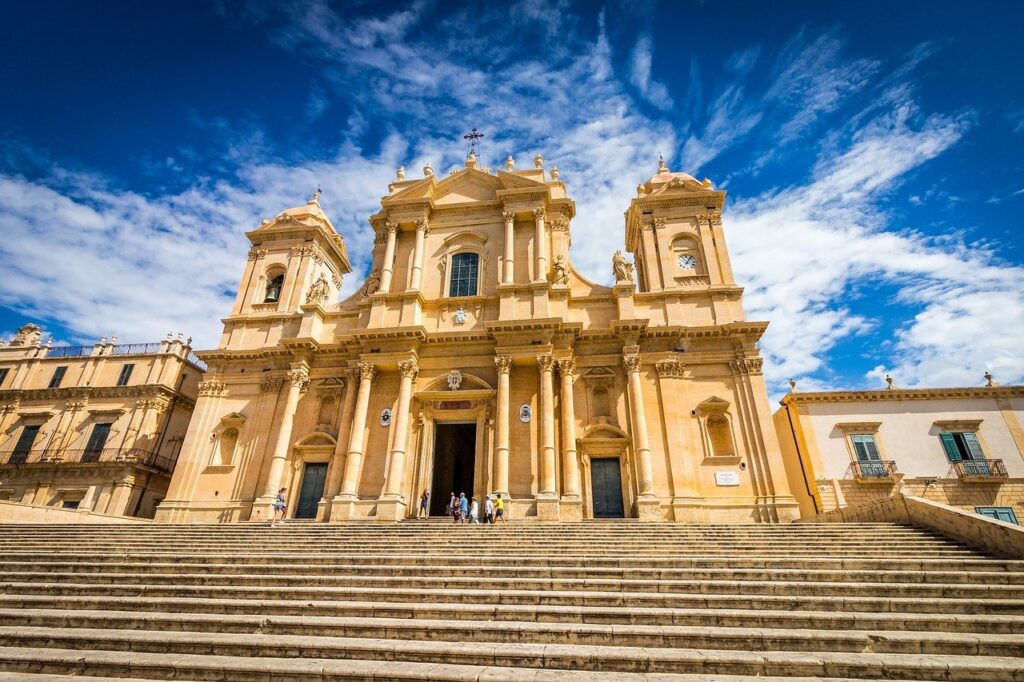
Another Baroque city and another UNESCO World Heritage site, what you see in Noto today is thanks to a massive 18th century rebuilding project to restore the city after it was devastated by the 1693 earthquake. Many of the buildings are the brainchild of architect Rosario Gagliardi along with Labisi and Sinatra. Their plan was to create a perfectly proportioned city using parallel lines running from east to west so that they always captured the sun. So accomplished a job did they do that many visitors and commentators now compare Noto to a film set, so beautiful is the result of their labours. There is no better time of the day to see Noto than in the late afternoon when the lowering sun leaves a wonderful golden glow on the buildings.
Noto’s 2 main roads are the Corso Vittorio Emanuele and the Via Cavour, which both run from east to west. Start your visit at the Porto Reale, the gateway to the historic centre and walk along the Corso Vittorio Emanuele from here. The road is flanked by Baroque palazzi and churches and is home to three piazzas each with their own church. The Monastero del Santissimo Salvatore is on this road as are the public gardens.
In fact, you are spoilt when it comes to beautiful architecture here but of particular note are the limestone cathedral, opposite which sits the equally stunning Palazzo Ducezio now home to Noto’s Town Hall. Head to the upper level to enjoy great views of the cathedral. Also worth a visit is the Palazzo Nicolaci di Villadorata nearby, a beautiful 18th century palace with an extremely pretty balcony. Another palace not to be missed is the Palazzo Castelluccio. Visitors have a Frenchman to thank for its current status. The property had been abandoned and empty for 30 years until a Frenchman, inspired by Giuseppe Tomasi di Lampedusa’s novel, The Leopard, bought the property and began working on restoring it to its former glory. And finally, pay a visit to the Teatro Tina Di Lorenzo as well.
You won’t be surprised to learn that Noto is also home to its fair share of churches too. The most notable are the Chiesa di San Carlo Borromeo, the Chiesa di San Domenico, the Chiesa di San Francesco d’Assisi all’Immacolata, the Chiesa di Santa Chiara and the Chiesa di Santissimo Salvatore. Climb the steps of the bell tower of the Chiesa di San Carlo al Corso to enjoy a great view looking down over the city.
If you can, visit Noto in May to coincide with the annual 3 day Infiorata when Noto’s streets are strewn a carpet of flowers, number 40 in our guide to the top 60 things to do in Sicily.
Novara di Sicilia
A typical Medieval Sicilian town, Novara di Sicilia, is home to five churches (Santa Maria di Noara, S. Nicolo, S. Antonio and S. George and Annunziata) along with a number of elegant palaces. Also worth a visit is the anthropological museum – Museo Territoriale – where you can learn more about the early culture of the local residents. Head to the top of the village to admire the views towards the sea and Aeolian islands.
Ortygia
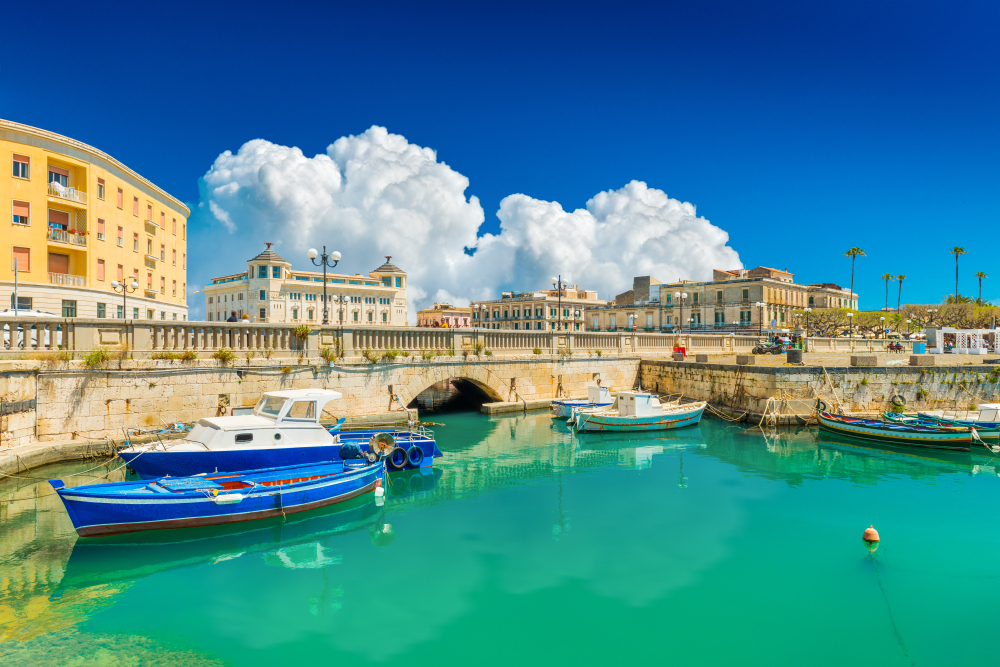
Accessed from mainland Syracuse via the Umbertino bridge, Ortygia is the the historical centre of the city of Syracuse (see below). Head to Ortygia in the morning to enjoy the wonderful daily outdoor food market (closed on Sundays). You’ll find tables piled high with delicious fruit and vegetables, the freshest seafood and fish. Just watching the stallholders is an experience not to be missed. Buy a local delicacy – u strattu – a natural tomato paste used to enrich sauces.
Palazzolo Acreide
A charming town off the main tourist trail, Palazzolo Acreide is home to some excellent examples of Baroque architecture. The religious buildings you may want to seek out include the church of San Michele, the church of St Nicholas and the church of Sant’Antonio Abate (which was rebuilt after the earthquake but has never been completely finished). The village can also lay claim to a world record – the 18th century Palazzo Lombardo Cafici on Via Garibaldi, boasts the longest Baroque balcony in the world. There was once a Medieval castle in the village but this was abandoned after the 1693 earthquake and is now just ruins. However, you can enjoy some incredibly beautiful views over the valley from here so it’s worth a visit.
Palazzolo Acreide is also the site of one of Sicily’s least well known ancient ruins. These are the ruins of Akrai, the first Syracuse colony, situated about 15 minutes from the centre of the town. Here you can view the ruins of the small Greek theatre which would once have accommodated around 600 spectators, as well as the Bouleuterion which sits next door.
Palermo
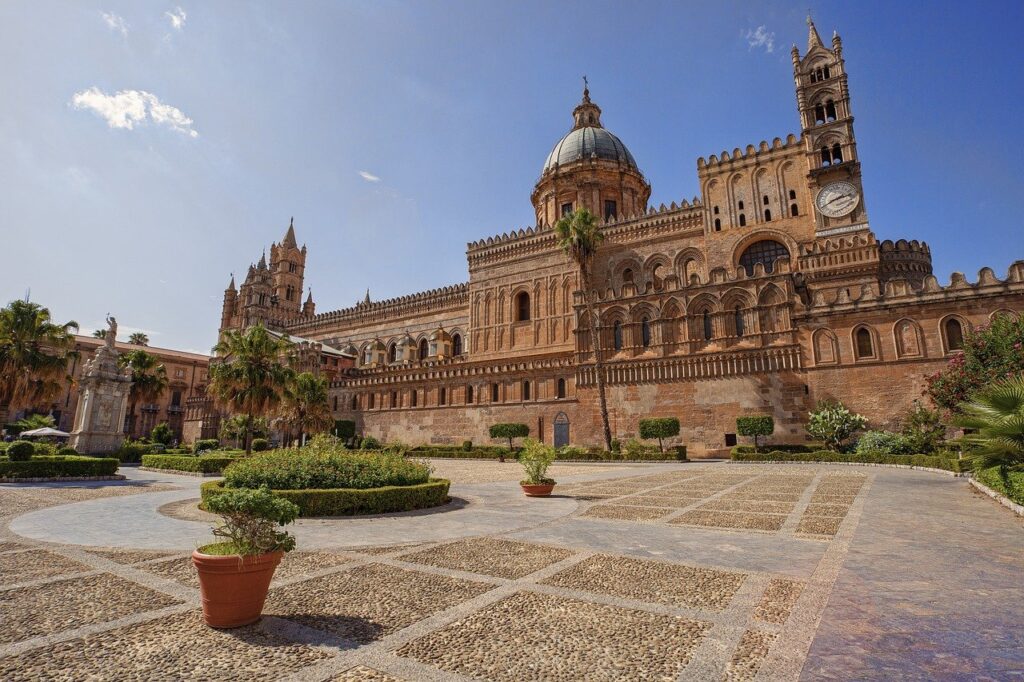
A visit to Palermo is number 2 on our guide to the top 60 things to do in Sicily. Palermo is Sicily’s vibrant capital. It’s an eclectic mix of styles reflecting its rich and eclectic history. This fusion of styles is never more visible than in the glittering Palatine Chapel where the European, Sicilian, Byzantine and Arabic influences are all clear to see. Palermo is also home to some incredible palaces including the Palazzo Comitini, Palazzo Sant’Elia, Palazzo delle Ferrovie, Palazzo Jung, Palazzo Abatellis, Palazzo Mirto and Palazzo Steri.
It’s also where you will find the much more macabre Catacombs of the Capuchins of Palermo. Here, 8000 mummified bodies are on display, of both adults and children that lived between the 17th and 19th centuries including what is claimed to be the most beautiful mummy in the world – the young Rosalia.
Not only that, Palermo is also home to Italy’s largest opera house and the third largest opera house in the world – the Massimo theatre. That’s not Palermo’s only claim to fame either. In the gardens of the Villa Garibaldi, you’ll find Europe’s largest tree. And let us not forget the Puppet theatre (Opera dei Pupi) and the Antonio Pasqualino International Puppet Museum where you can learn more about this fascinating creative tradition.
And if all this sightseeing brings on an appetite, then you needn’t worry. Palermo has a lively and delicious street food scene. If you’re a keen foodie, then Palermo has to be on your bucket list.
Find out more about what to see and do in Palermo on our blog.
Petralia Soprana
One of Sicily’s best preserved villages, Petralia Soprana manages to enchant all the visitors that wander round its pretty streets. The highest village in the Madonie mountains, the village is characterised by old stone houses with their wrought iron balconies, with narrow paved streets broken up every now again by a church.
Piazza Armerina
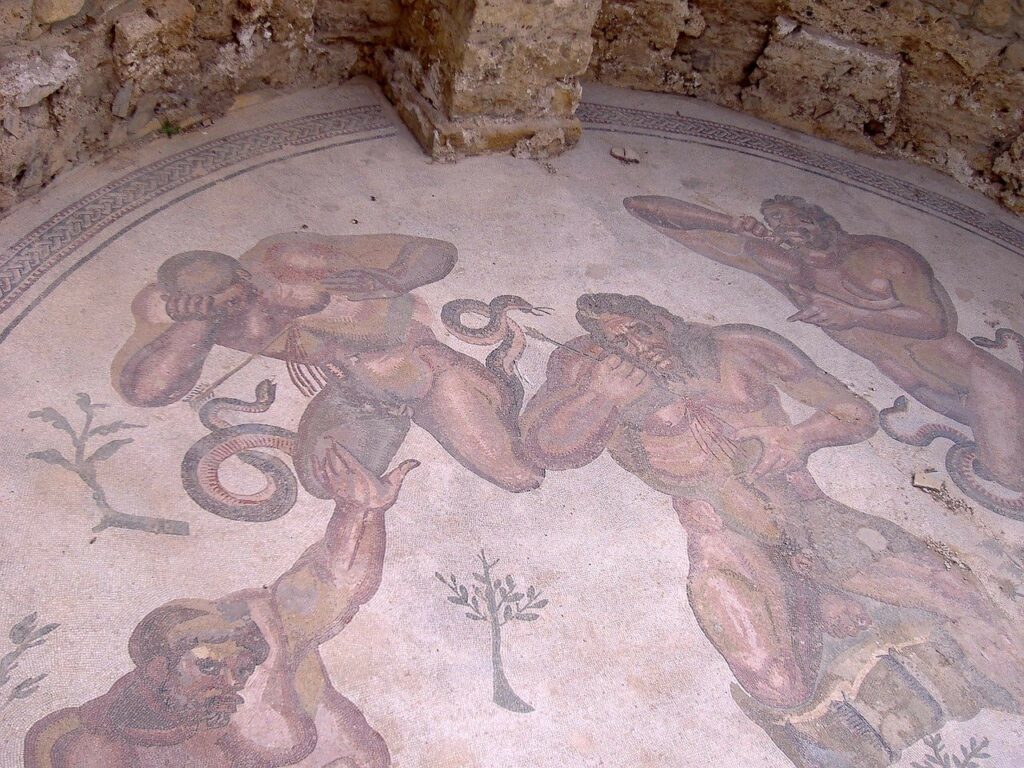
Piazza Armerina is, without doubt, most famous for the incredible collection of mosaics in the 4th century Villa Romana del Casale. Housing some of the largest and best preserved Roman mosaics in the world both on the walls and on the floor, the site was granted UNESCO World Heritage status in 1997. Today, visitors can explore several different parts of the villa including the the porticoed, entrance courtyard and spa complex as well as the honorary arch, vestibule and central courtyard. Don’t miss the chance to see the most famous of the mosaics – the ten female gymnasts or athletes in bikinis. Also on display to visitors are the servants quarters and the Palestrite room, the formal dining room (triclinium), the basilica and both the Northern and Southern apartments.
There are attractions to see in Piazza Armerina’s hilltop Medieval centre too, where life revolves around the central Piazza Garibaldi. Most notable is the cathedral with its 14th century belltower and the Aragonese Castle built in the late 14th century and which dominates the skyline.
Visit in mid August to witness the Palio dei Normanni, an annual jousting tournament remembering the Norman invaders that ousted the Arabs from Sicily in the 11th century.
Ragusa
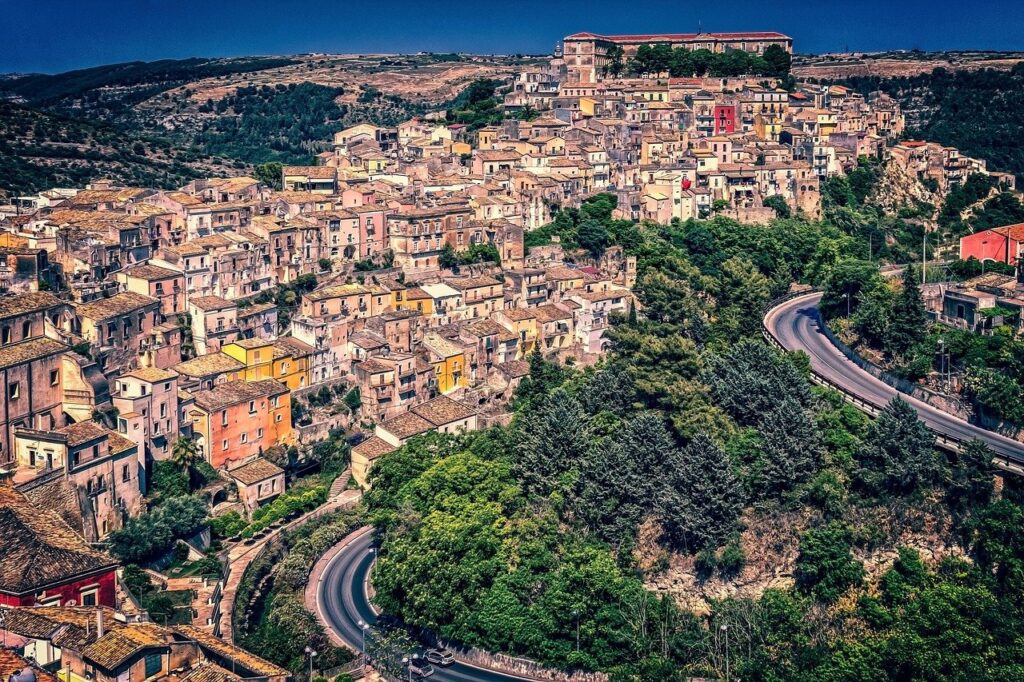
One of Italy’s UNESCO World Heritage sites, Ragusa is divided into two parts – the less appealing busy modern town of Ragusa Superiore above and the mass of alleyways, beautiful piazzas and Baroque palazzi of Ragusa Ibla below.
Whilst it may have less appeal, Ragusa Superiore is still worth a visit. It is home to an excellent archaeological museum and can boast some excellent shops and restaurants, elegant streets, its own Duomo – the Cattedrale di San Giovanni Battista – and noble palazzi. Plus, it’s worth venturing into the upper town simply for the views from here of Ragusa Ibla on its separate hilltop, views that continue as you descend with the hilltop town spread out before you in an unforgettable panorama. It’s not surprising that the latter is frequently used as a backdrop for scenes for Inspector Montalbano (following in the footsteps of this TV detective is number 39 in our guide to the top 60 things to do in Sicily).
But Ragusa Ibla is the district you’ll just want to spend hours exploring, making your way through its winding streets. No visit would be complete without seeing the 18th century cathedral though – the Duomo di San Giorgio – and the adjacent Museo del Duomo, where you will find statues and artefacts from the original pre-earthquake churches of Ragusa. Also set aside some time to simply relax in the town’s public park, the immaculately tended Giardino Ibleo, with its impressive views over the valley below.
Salemi
Again, another of the ‘borghi piu belli d’Italia’, Salemi was where Garibaldi proclaimed himself ruler of of Sicily in 1860. Unfortunately, much of the old part of the village was badly damaged in an earthquake in 1968 but it remains charming despite the post earthquake building and construction. Salemi is also home to some interesting museums including the archeological museum, the Museum of the Resurgence, the Museum of Sacred Art and the fascinating Museum of the Mafia.
Sambuca di Sicilia
Situated at the foot of Mount Genuardo, Sambuca di Sicilia is well known for its excellent examples of traditional Arab buildings such as the Vicoli Saraceni (Li Setti Vaneddi) and Mazzallakkar fortress. Until 1928, the town was called Sambuca Zabut when Mussolini removed ‘Zabat’ and instead added ‘di Sicilia’. The village gained significant media attention in January 2019 when it sold homes in an auction with a starting price of just 1 euro to attract new residents to the area.
Sampieri
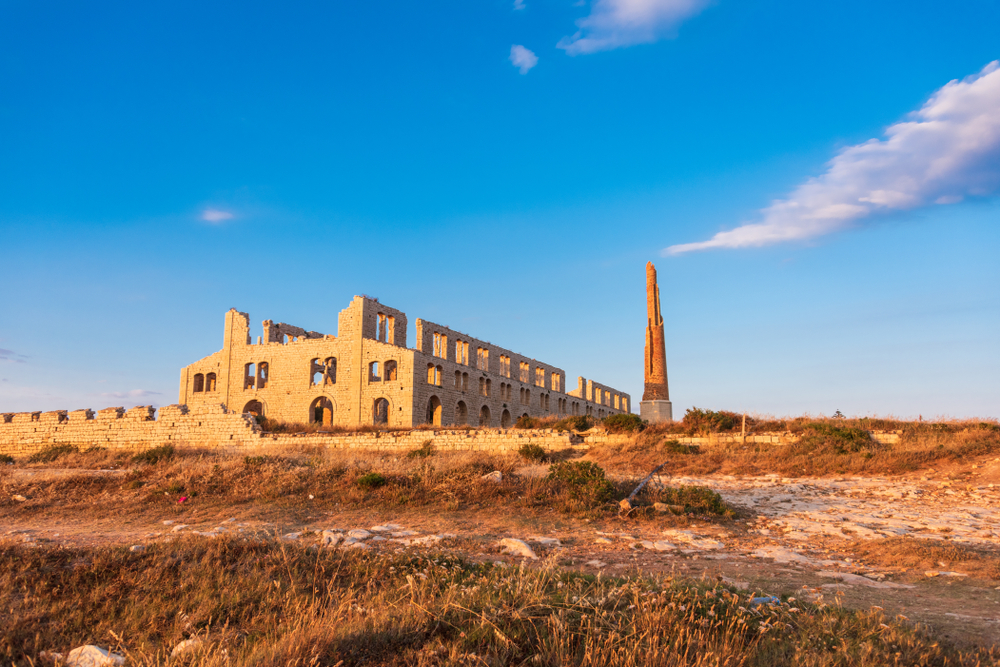
A small 19th century seaside town, Sampieri also boasts a superb crescent shaped beach, bordered by golden sand dunes. This is overlooked by the Fornace Penna, a brick factory that was built in 1912 but abandoned just 12 years later in 1924. There is a real beauty and charm to the disused building though, especially in the late afternoon and early evening light.
San Marco D’Alunzio
Yet another of the ‘borghi piu belli d’Italia’, San Marco D’Alunzio has a charming and authentic atmosphere. The town’s main landmark is the remains of the Norman castle but it’s also home to the remains of a Greek temple dedicated to Hercules. And as with so many of the towns in Sicily, there are a plethora of beautiful churches to discover, from many different historical periods including the Byzantine, Renaissance and Baroque.
Santa Maria la Scala
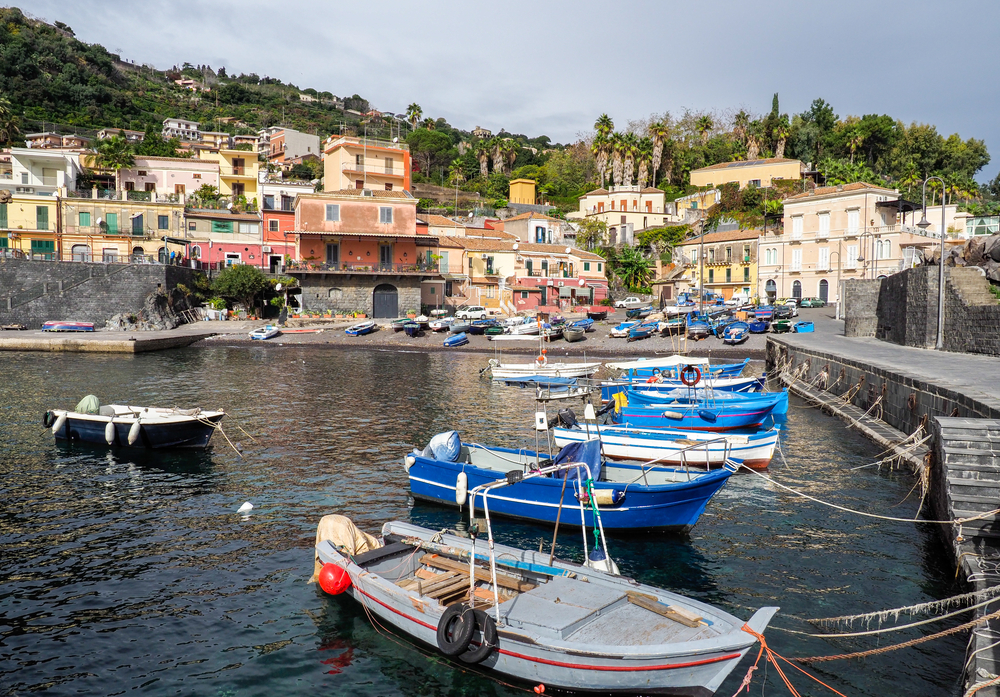
This is a tiny fishing village just a 2 kilometre walk downhill from Acireale. The black lava cliffs behind contrast perfectly with the colourful bobbing boats of the fisherman below.
Sant’ Ambrogio
A typical Sicilian village built into the hillside, this is a charming location and a good base for exploring the very best that Sicily has to offer. Winding alleyways connect the houses and there is a small piazza with seating where you can sit and admire the views. It may only be home to a few hundred residents but it can boasts three excellent restaurants, grocery store, a couple of bars and a small off license.
Check out this villa in Sicily just a couple of minutes from Sant’ Ambrogio.
San Vito Lo Capo
A popular seaside town, San Vito Lo Capo is filled with sun worshippers in the Summer months. Its white sandy beach has been awarded Blue Flag status numerous times and its crystal clear water is a paradise for swimmers, snorkelers and scuba divers. The town itself is mostly modern, but there are a couple of interesting 19th century buildings such as the Palazzo La Porta, now the town hall, along with the Church of Saint Vitus Martyr, home to the ancient relics of the the town’s patron saint. Also worth a visit is the Museo del Mare in San Vito Lo Capo which has numerous archaeological finds from ancient local shipwrecks on display. And finally, there is the Tonnara del Secco, evidence of what historically was the main occupant of the residents that lived here – tuna fishing.
San Vito Lo Capo also plays host to an annual couscous festival each September (number 25 on our guide to the top 60 things to do in Sicily).
Savoca
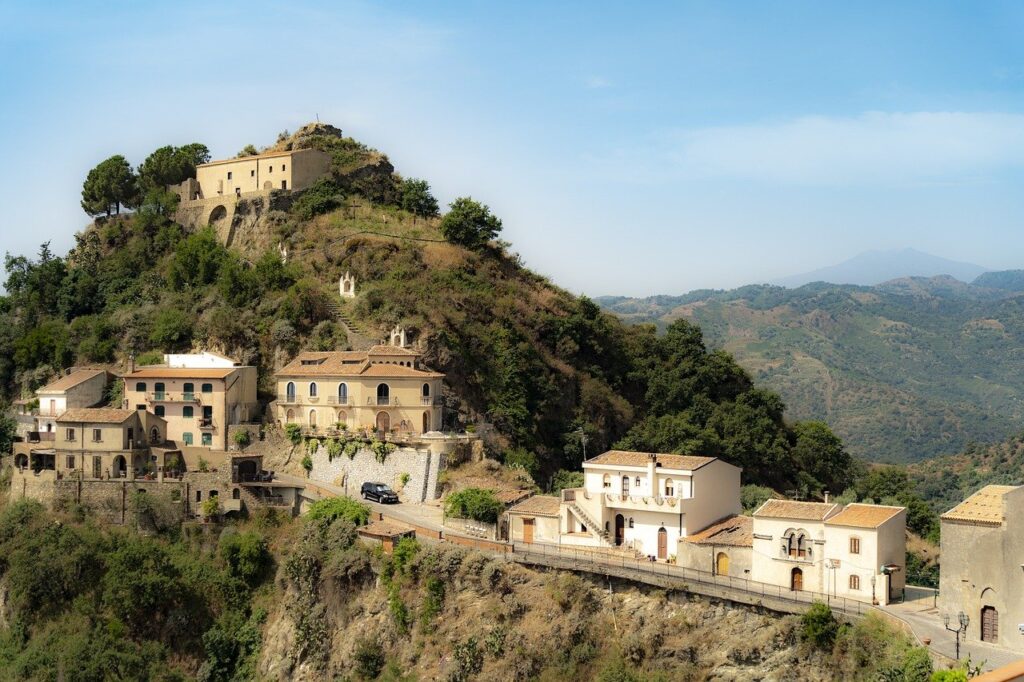
One of the things Sicily has arguably become most famous for in recent years is the series of Godfather films and fans of Francis Ford Coppola shouldn’t miss the opportunity to head to Savoca to enjoy drinks at the Bar Vitelli where scenes for the Godfather movie were set. The village is also home to a small museum where visitors can enjoy photographs, exhibits and paraphernalia related to the film as well as information about the history of the village. Whilst Savoca is arguably beginning to lose some of its authenticity to guided Godfather tours, we think it’s still well worth seeing. The village is made up of clusters of dwellings (some still abandoned despite a recent restoration project) and churches but it is easily explored on foot and throughout the village you are treated to wonderful views over the valleys below. Don’t miss seeing the catacombs at the Convento dei Cappuccini (Capuchin monastery) which is a short stroll from the main town square.
Sciacca
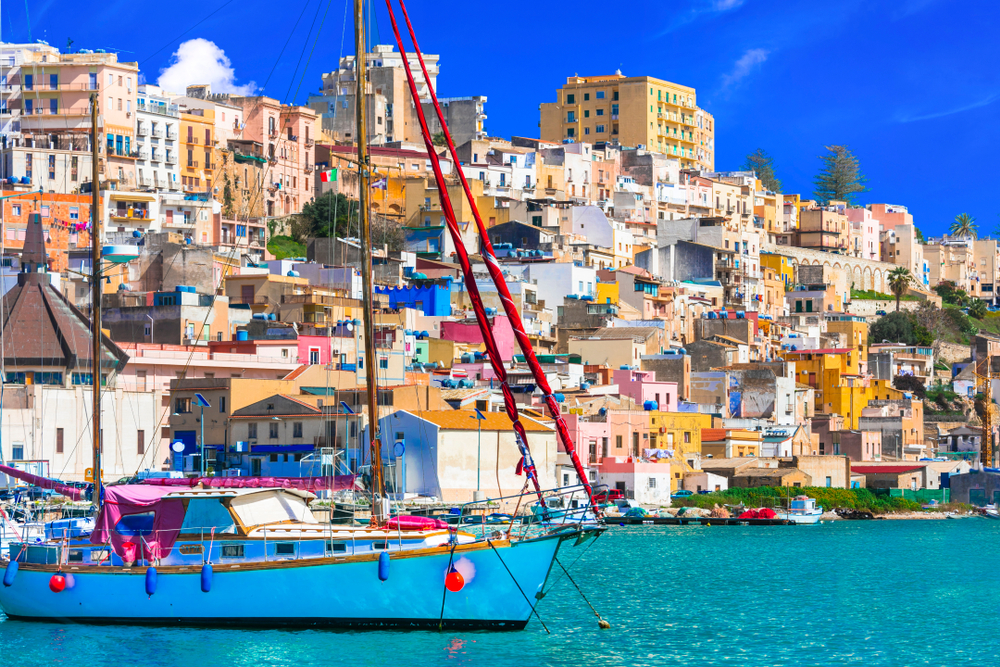
Sciacca is a historic fishing port on the Southern coast of the island, now famous for its ceramics, thermal baths and religious festivals. It’s the perfect stopping point if you want to enjoy an authentic slice of Sicilian life. Find out more in our guide to Sciacca.
Scicli
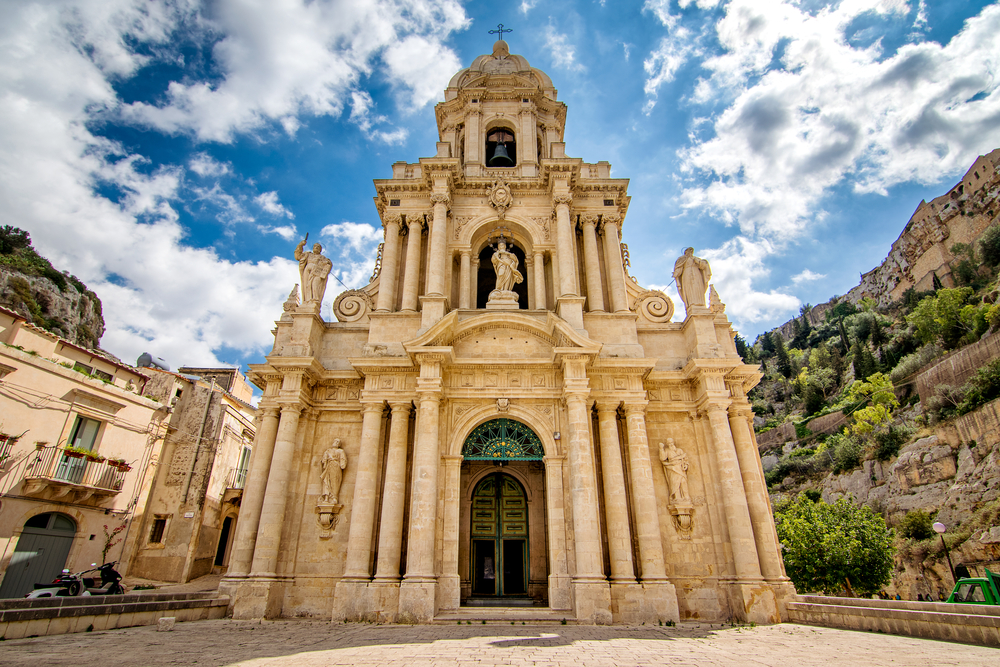
Scicli is another of the Baroque towns included within the Val di Noto and it is literally jam-packed with cultural delights, from beautiful churches to fascinating museums and aristocratic palazzi. It’s also a regular setting for the hit TV series Inspector Montalbano. It was built around two valleys divided by steep ridges. These ridges were once the site of cave dwellings but any residents in these caves had moved out by the 1950s, leaving the upper slopes of the town abandoned along with the Church of San Matteo.
Just because the church is abandoned doesn’t mean it’s not worth visiting. To enjoy wonderful sweeping views over the town, take a 10 minute walk from the Palazzo Beneventano to the Chiesa di San Matteo. The walk to the church is worth it purely for the views alone. But, from here you can talk a pathway that continues up the ridge to the church of Santo Spirito and, beyond that, an overgrown path to the abandoned cave settlement of Chiafura.
The town boasts numerous other churches and palaces. The most charming street to stroll along is the Via Penna, an elegant pedestrianised street which is literally lined with 18th century noble Baroque palaces (including the Palazzo Spadaro, Palazzo Bonelli, Palazzo Donzelli-Iacono, Palace Conti, Palazzo Papaleo and Palazzo Carpentieri) and churches (among them the Church of San Giovanni Evangelista, the Church of Santa Teresa and the Church of San Michele), all built using the local white stone.
Head to the end of this street and make your way to the Piazza Italia where you will continue to be mesmerised by the beautiful buildings including yet more palaces – the Palace Massari, Palace Iacono, Palace Scrofani, Palace Fava – and by the Church of Sant’Ignazio. However, probably the most striking and ornate of all the palaces in Scicli is the Palazzo Beneventano on Via Duca d’Aosta.
Scoglitti
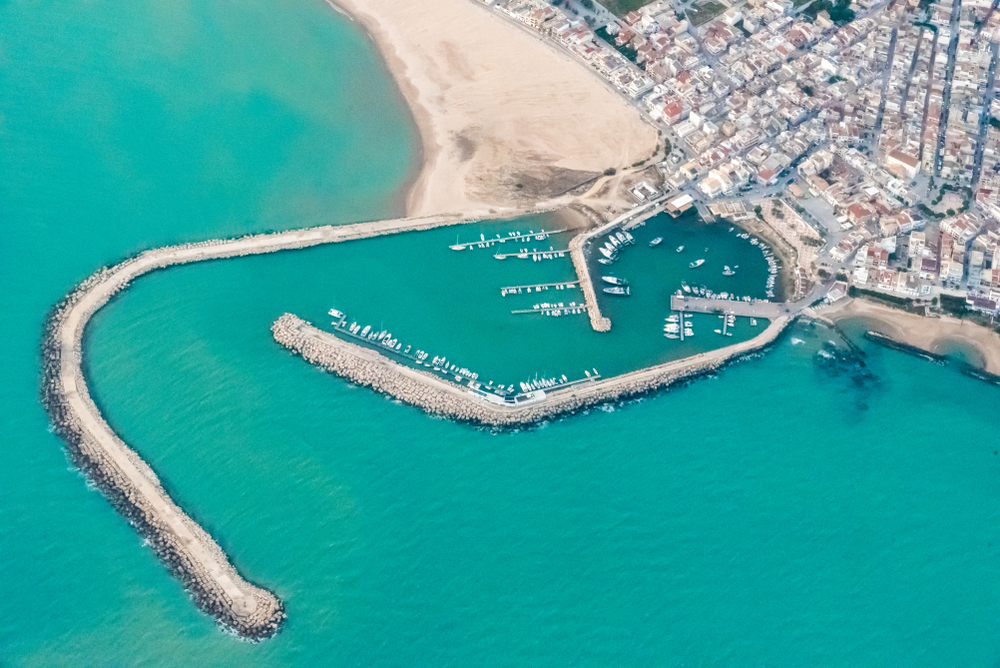
A tiny village which was important in the last century thanks to its fish salting industry. Whilst the industry no longer remains, it’s still an attractive village to visit to see the beautiful church of St Francis, the Portosalvo Madonna Church and the lighthouse.
Scopello
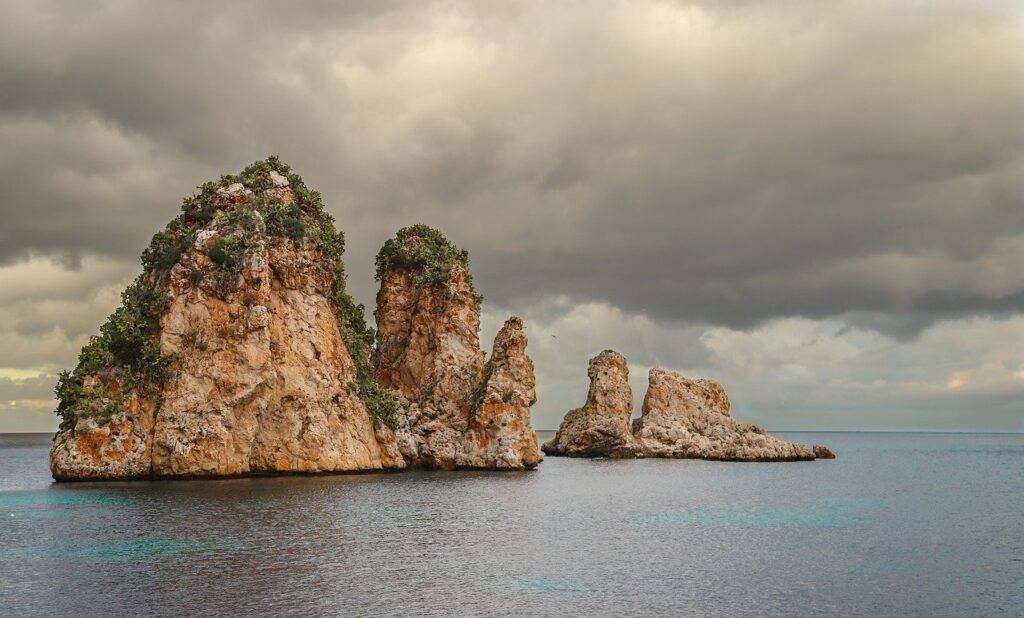
Scopello is a fascinating and picturesque seaside hamlet built around an 18th century fortified baglio (farmstead and manor house) boasting a couple of restaurants and bars along with a grocery store and post office. In a small bay within the village sits the tonnara (tuna fishery), a pale yellow, creamy coloured building where, in the Summer months, you’ll find people sunbathing on the landing area and swimmers enjoying the beautifully clean and clear turquoise waters below. So pretty is this setting that it’s often used as a film location including as a setting for Ocean’s Twelve and the popular TV detective series, Inspector Montalbano.
Segasta
In Segasta, you’ll find one of the best preserved Greek temples in the world. Rather unimaginatively named the Temple of Segasta, the 36 columned Doric temple measures 61 metres long and 26 metres wide and sits atop a hill surrounded by beautiful countryside stretching down to the sea. Interestingly, the temple is without a roof, and it is believed that the building remained unfinished due to an attack on the settlement of Segesta.
On a nearby hill – Monte Barbaro – a short but steep walk away, is another Greek ruin, a semi-circular theatre that dates back to the same period. The wonderful views provide a stunning natural backdrop to any stage performance. Head here during the Summer months to enjoy one of the modern plays or concerts put on here.
In the town itself, visitors will find more recent historical art and artefacts including the ruins of a Norman castle, a small church and a mosque.
Selinunte
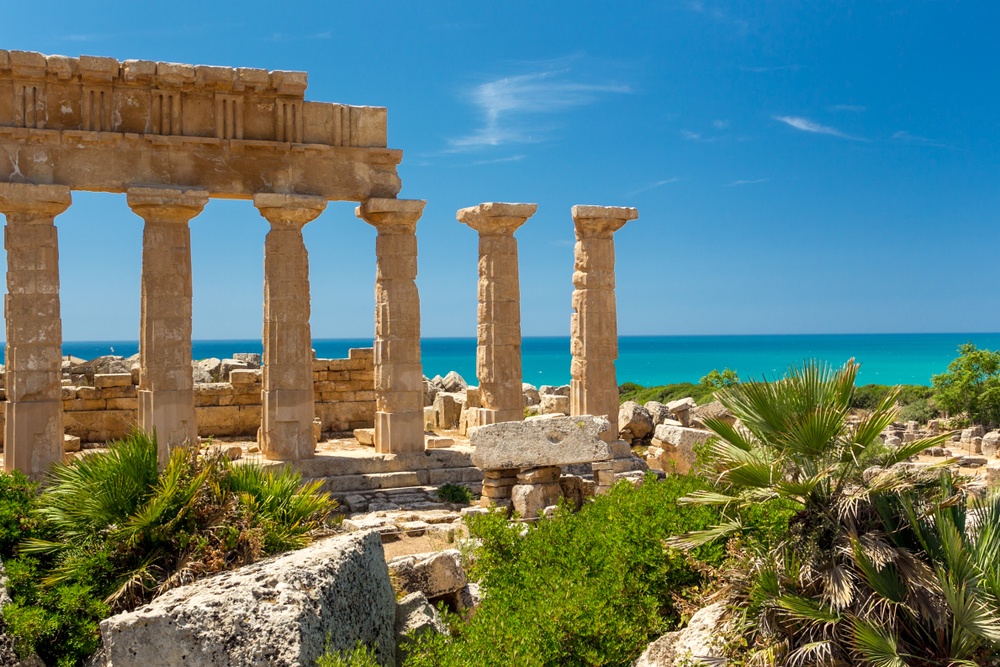
Home to the largest archaeological site in Europe, we think it must also be one of the most beautiful settings of any archaeological site. Its elevated position means those visiting are treated to magnificent views in all directions and the site is flanked on either side by stunning golden sandy beaches. It’s impossible to imagine the sheer scale of the site until you are there so do allow a good few hours to do it justice, bring plenty of water and wear sensible shoes. You could easily be walking 6-8 km to be able to explore the key remains.
Sperlinga
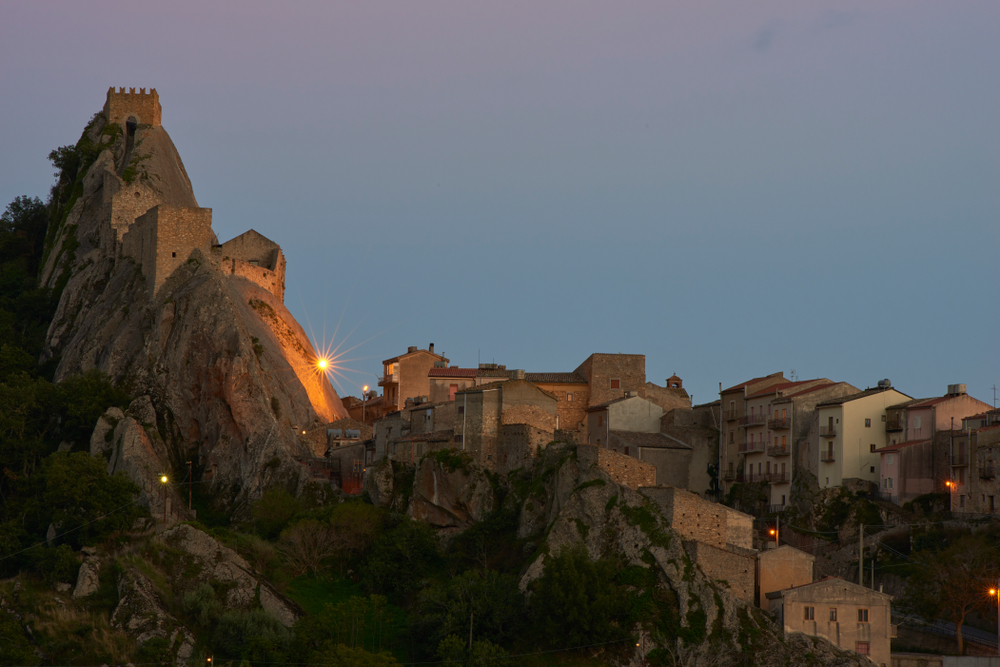
One of the ‘borghi piu belli d’Italia’, Sperlinga is a village that has literally been dug into the rocks. Climb the rather steep staircase to reach the top of the craggy cliffs and admire the impressive 12th century Norman castle and the 50 man-made caves (aggrottato) below. These one or two room dwellings would once have been inhabited (in fact some were still lived in until the 1960s) but they are now part of a museum that contains artefacts discovered during the excavations including pottery, utensils and other household implements. Before you go, make sure you take time to visit the ‘Park of the Duke’ for a gentle stroll to admire the beautiful flora and fauna.
Try and visit during the annual Sagra del Torrone. Residents will dress in Medieval costumes and there will be plenty of opportunities to sample the delicious ‘torrone‘, a slightly chewy sweet similar to nought made with almonds, nuts, honey and cinnamon.
Sutera
Sutera is dominated by the large monolithic rock that towers above it. On Feast Days, the residents of the town will walk to the top of the mountain as a pilgrimage to their two saints – San Paolino and San Onofrio. For those holidaymakers that can muster the energy, we certainly recommend that you also climb the 183 steps that lead up from the Piazza del Carmine to the top of the 812 metre high Monte San Paolino. Here you will find the sanctuary of San Paolino and the adjacent 18th century convent of the Philippine Fathers in which two urns hold the bones of the town’s two patron saints. The views from here of the coastline and Mount Etna in the distance are also spectacular.
From here you can also discover the Rock of San Marco, a large cave 70 metres deep that is home to Byzantine style frescoes representing the four Evangelists, the Virgin Mary and St Paulinus.
Sutera itself is a Medieval town characterised by narrow limestone streets. The most notable cultural attractions are the 14th century Church of Maria SS Assunta along with the Francesco Salomone Palace built by the aristocratic Salomone family in the 15th century.
Syracuse
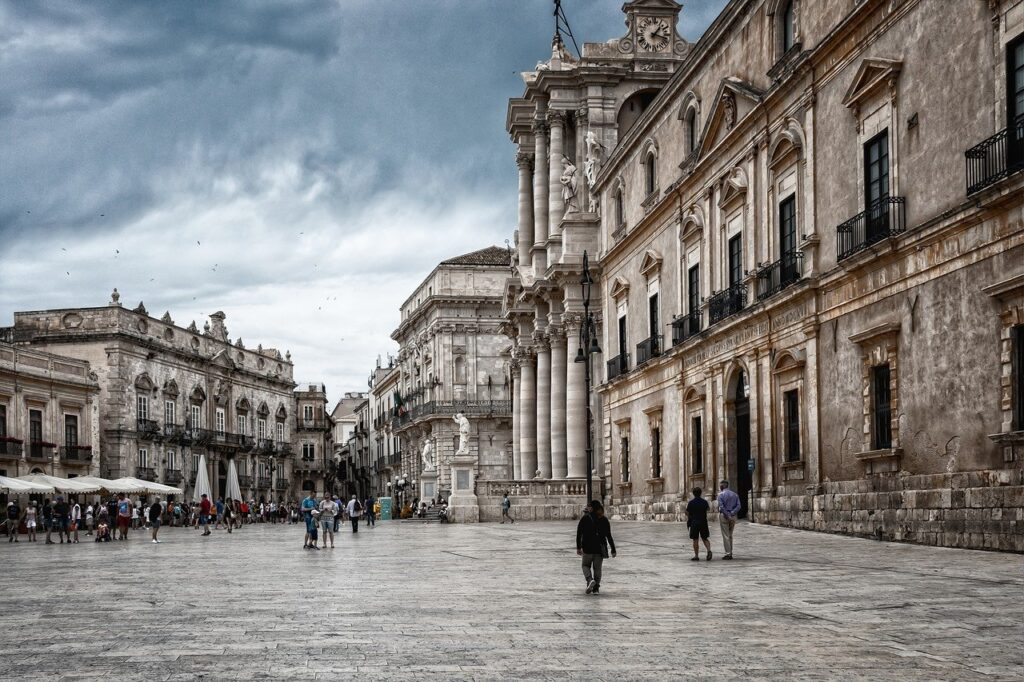
In its heyday, Syracuse was described by Cicero as the ‘greatest Greek city and the most beautiful of them all. ‘ It was certainly the most powerful city in the Mediterranean at one point and was the birthplace of Archimedes and the home to both Plato and Pythagoras. There is a square dedicated to Achimedes in the heart of Syracuse – the Piazza Archimede – with the 9th century Fontana Diana at its centre.
These days, we still think Syracuse is a rather magical place. The Piazza Duomo in is arguably one of the most beautiful squares in Italy. It is where you will find not only the cathedral with its Baroque facade and surprising Doric columns behind, but also the Church of Santa Lucia alla Badia. The latter is where you will discover Caravaggio’s masterpiece, ‘The Burial of Saint Lucy’.
Other key religious buildings include the Santuario della madonna delle Lacrime (Santuary of Our Lady of Tears). Inaugurated by Pope John Paul II in the 1990s, the building was modelled on the shape of a tear drop and was constructed to house an image of the Madonna that allegedly wept real tears for four consecutive days back in 1953. To find out more about this event, visit the Museo della Lacrimazione on the lower floor of the sanctuary. (This is number 17 in our list of 60 things to do in Sicily). The oldest Doric temple in Ortygia – the Temple of Apollo – was also a Christian church at one time, then a mosque, then again a Norman church and finally, during the time of Charles V, it served as a barracks.
There is also a castle of note in Syracuse – the Maniace Castle – which is not accessible to tourists and a beautiful fountain which is – the Fonte Aretusa. The fresh water spring here has created a small semi-circular lake where you will find fish, geese and ducks happily living and where natural papyrus grows in abundance.
Given its historical importance, it’s probably not surprising to learn that Syracuse is also home to some impressive Greek and Roman remains, the most important of which is the Greek theatre dating back to the 5th century BC. Seating 15,000 spectators across 59 rows, it can lay claim to being the largest auditorium (cavea) ever built and is still used today for an annual festival of Greek theatre which runs from mid May to the end of June each year.
Almost as impressive is the Roman amphitheatre. At 140 metres long, this can also lay claim to being one of the largest amphitheatres ever built, similar in size to the Verona Arena. Once the setting for bloody gladiatorial battles with wild animals, it’s possible to see the central hole that is thought to probably have been a drain for all the blood and gore.
Other archaeological remains include the huge Altar of Hieron II where the Romans would have made public sacrifices and the catacombs of San Giovanni Evangelista, an underground complex where followers of the new Christian religion would have been buried in Roman times. For those looking to learn more about this period, many of the artefacts discovered in the excavations of the site can be found in the Museo Archeologico Regionale Paolo Orsi in Syracuse, one of Europe’s prestigious archaeology museums.
Not far from the Greek theatre are the old stone quarries (latomie). The current lemon groves that are here make it hard to imagine its past use as a place to hold Athenian prisoners of war. But, the most famous sight here is the Ear of Dionysius, a famous man-made cave in the shape of a giant ear. The story goes that it was built by a local tyrant – Dionysius I of Syracuse – who ordered that the grotto be built to contain his prisoners, leaving an opening in the ceiling so that, unseen from above, he could hear the prisoners whispering their secrets and gain the upper hand. Certainly, visit today, whisper your secrets whilst inside the ear and they will be heard by everyone inside, no matter whether they are next to you or at the opposite end of the cave! The acoustics are second to none.
We also have Dionysus I to thank for the Eurialo Castle. Built to complete the great defensive system of Dionysian walls, only ruins now remain standing but it’s still an impressive site to visit.
A visit to Syracuse is number 21 on our list of 60 things to do in Sicily.
Taormina
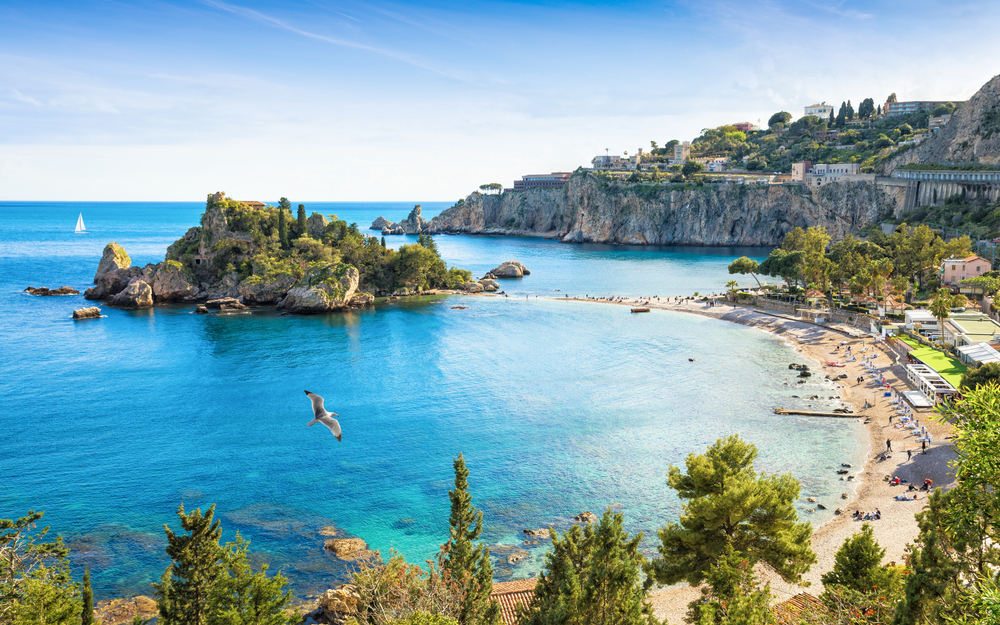
Taormina should need no introduction as it’s one of Sicily’s most popular and famous resorts. Nestled near Mount Etna on Sicily’s Eastern coast, it is a picturesque town that has been welcoming tourists for over 100 years. Its most famous attraction is certainly the Teatro Greco, an incredibly well preserved Greco-Roman theatre that also enjoys fantastic views both of the coastline and Mount Etna. Isola Bella is another of Taormina’s draws for tourists. A small, beautiful island connected to the mainland by a narrow strip of beach the island is now a nature reserve managed by the WWF. Check out all the other things to see and do in our guide to Taormina.
Tindari
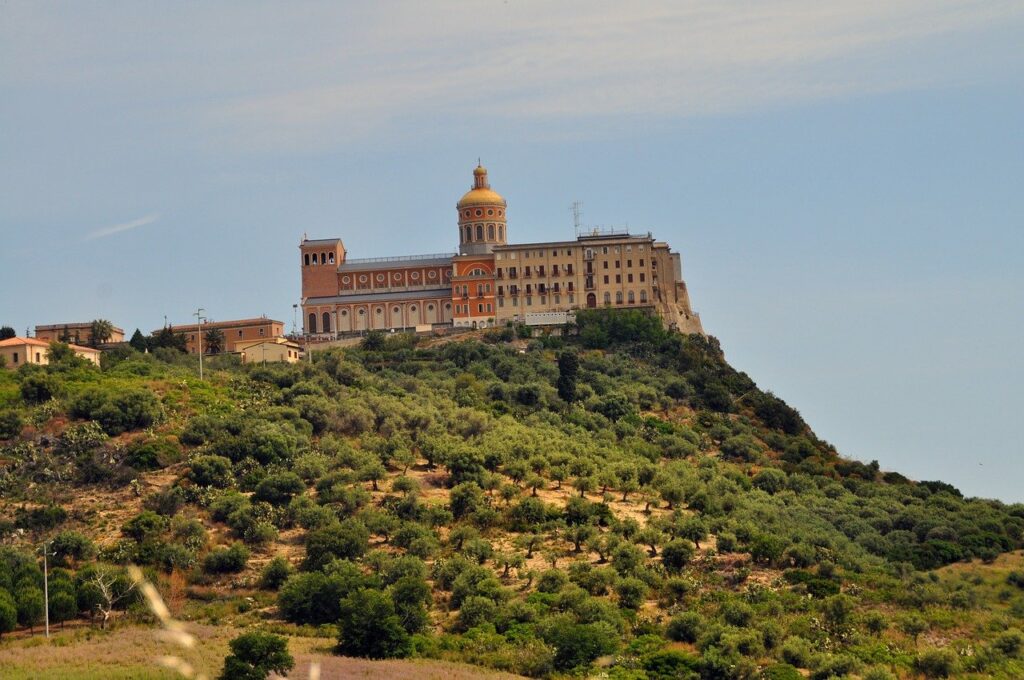
Tindari is dominated by the Sanctuary of the Black Madonna of Tindari (Santuario della Madonna Nera) which sits atop Mount Tindari and enjoys stunning views over the Tyrrhenian Sea across to the Aeolian Islands. Now a pilgrimage site but once the site of an ancient Greek town, it is home to some incredible ancient Greek and Roman archaeological ruins. Highlights include long stretches of defensive walls, a Roman theatre, thermal baths, some excellent mosaics and a basilica. Visit in the Summer months and try and time your stay to coincide with one of the Summer performances they put on in the old 4th century BC Greek theatre.
As the name suggests, the sanctuary itself is where you will find the famous statue of the Black Madonna. The statue dates back to 800 AD and is believed to have miraculous powers to protect Sicilians from danger. It stands behind the altar with the powerful inscription ‘Nigro sum sed formosa‘ (I am black but beautiful) below it.
Sat below the archaeological site at the bottom of the cliffs is a sandbank, known as the linguetta di sabbia, which stretches 1.5 km into the sea and reaches 4 metres above sea level at its highest point, creating a sort of lagoon. It’s home to an array of flora and fauna and it’s worth swimming or walking out to admire it more closely.
Trapani
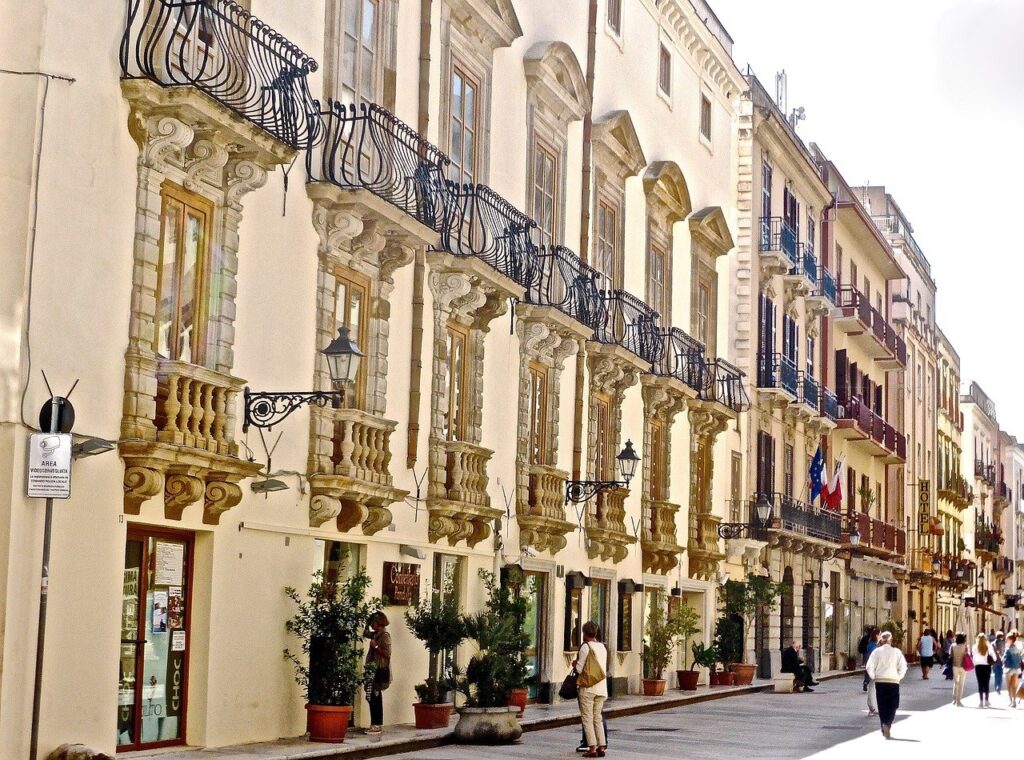
Bordered by the Tyrrhenian Sea to the north and the Mediterranean Sea to the south, and positioned facing the beautiful Egadi Islands, Trapani sits in an enviable, sickle shaped position. In fact it sits closer to Africa than it does to mainland Italy! Certainly, many visit simply as a way to get to the Egadi Islands. However Trapani is worth a visit in itself.
The city does have an industrial side due to the fact that it’s a working port. And, the historic centre is perhaps not as photogenic as some other Sicilian towns but nonetheless it has been well restored and it has a charm and elegance to it. During the day, head to the main shopping street – the Via Giovanni Battista Fardella – where you’ll find plenty of clothing shops and independent boutiques. But in the evening, make a beeline for the pedestrianised Corso Vittorio Emanuele or the Via Garibaldi instead where you will find plenty of bars, cafes and restaurants spilling into the streets.
There are a few attractions of note in Trapani. First, at the Western tip of the town is the Torre di Ligny, once a key defensive fort but now home to the Museo Civico. Also of note is the Cathedral of San Lorenzo, the three tiered Baroque Palazzo Senatorio (now the town hall) with its twin clock tower and the 14th century Sanctuary of the Annunciation with its massive Baroque bell tower. Finally, check out the Palazzo della Giudecca which can be found in the Jewish Ghetto of the city built in the typical ‘Catalan’ style as well as the Agostino Pepoli Regional Museum. Housed in a former convent, this is one of the most important art, archaeology and local history museums in Sicily.
Troina
Troina is home to the first cathedral to be founded by the Normans in Sicily, dedicated to Maria Santissima Assunta. Also of note is the Oratorio dei Bianchi.
To immerse yourself in Sicilian culture, visit during the Festa dei Rami on the second to last Sunday in May. This festival dates back to pre Christian times and honours the town’s patron saint, San Silvestro. Branch pickers (ramara) make a pilgrimage through the woods to the Anghira di Faccilonga ravine in the the heart of the Nebrodi Mountains where, with the help of ropes, they scrabble down the hillside to gather the laurel. Returning to the village carrying their splendid leafy decorations, they are welcomed by the villagers with a bountiful supply of food to continue the festivities.
Zingaro
The Zingaro nature reserve is an incredibly delightful stretch of coastline between Scopello and San Vito Lo Capo. A protected nature reserve, it is a nature lovers and walkers paradise made up of picturesque coves, dramatic cliffs that fall into crystal clear turquoise seas and beautiful landscapes with a plethora of flora and fauna. Over 650 different species of plant thrive here from sea lavender to dwarf palms and from orchids to anemones.
Now that you’re read our guide to Sicily, if you want to discover Sicily for yourself, then check out the full range of villas in Sicily available to rent for your next Sicilian holiday.
Want to discover more about Italy? Then check out our other A to Z guides to Italy:
A to Z guide to Tuscany
A to Z guide to Puglia
A to Z guide to Umbria
A to Z guide to Le Marche
A to Z guide to Lake Maggiore
A to Z guide to Emilia Romagna
